 By Staff By Staff
August 14th, 2020
BURLINGTON, ON
For those who want to get deeply into the weeds on just what the province is telling the school boards what they are required to do the Memorandum from the Ministry to the Boards wiill be interesting.
Purpose
The Ministry of Education is committed to ensuring that students1 across Ontario receive a consistent approach to remote learning in times of extended interruption to conventional in-person learning, such as when public health emergencies, pandemics, natural disasters, or other unplanned events force the closure of classrooms or schools.
This memorandum provides direction to school boards2 on remote learning requirements, including implementation and reporting. This memorandum also identifies effective practices that school boards should develop to support students during remote learning.
 Classes like this will be difficult to hold. During full or partial school closures, or under any other periods of remote learning, it is crucial to keep students engaged in their learning. Students should have access to a school community, a support network, and authentic educational experiences in order to continue to progress in their learning.
This memorandum must be implemented in alignment with collective agreements. Where there is a conflict between the memorandum and a collective agreement, the collective agreement must prevail.
Definitions of “Remote”, “Synchronous”, and “Asynchronous” Learning
In the context of this memorandum, “remote learning”, “synchronous learning”, and “asynchronous learning” mean the following:
Remote learning: Learning that occurs when classes are taught at a distance and when students and educators are not in a conventional classroom setting. Remote learning takes place in times of extended interruption to in-person learning – for example, as a result of a pandemic or natural disaster. Classes can be synchronous or asynchronous and can be taught online through a Learning Management System (LMS) or by using videoconferencing tools. In some cases, they may be delivered through emails, print materials, broadcast media, or telephone calls.
Synchronous learning: Learning that happens in real time. Synchronous learning involves using text, video, or voice communication in a way that enables educators and other members of the school- or board-based team to instruct and connect with students in real time. Synchronous learning supports the well-being and academic achievement of all students, including students with special education needs, by providing educators and students with an interactive and engaging way to learn. It helps teachers provide immediate feedback to students and enables students to interact with one another.
Asynchronous learning: Learning that is not delivered in real time. Asynchronous learning may involve students watching pre-recorded video lessons, completing assigned tasks, or contributing to online discussion boards.
Remote Learning Requirements for School Boards
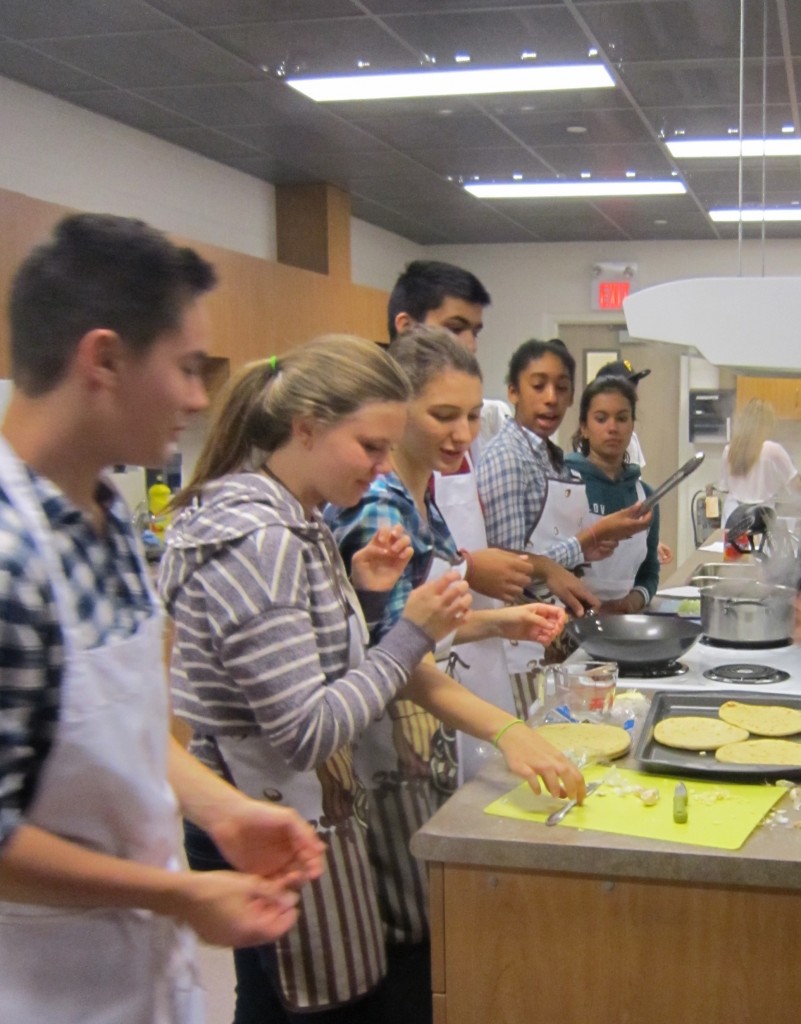 Classes like this won’t take place as long as the pandemic is with us.
2. Minimum Requirements for Synchronous Learning
During periods of remote learning where students are at home for more than three days in a given week, boards must ensure that students are provided with synchronous learning. The minimum requirements for synchronous learning help to ensure that students have access to both synchronous and asynchronous learning opportunities.
The scheduled synchronous learning sessions must be communicated to parents and students. Educators should use their professional judgement to provide some flexibility to students on an individual basis when students are unable to participate in synchronous learning.
The table below outlines the minimum amount of time per day that students, depending on their grade level, must be provided with synchronous learning as part of their scheduled or timetabled learning.
Division Grade Level of Students Daily Minimum Synchronous Learning Time Requirement*
Elementary Kindergarten 180 minutes
Grades 1 to 3 225 minutes
Grades 4 to 8 225 minutes
Secondary Grades 9 to 12 The higher of 60 minutes for each 75-minute class period** or 225 minutes per day for a full course schedule
* This is in addition to asynchronous learning time.
** The synchronous learning time requirement for any period that is not 75 minutes should be adjusted to reflect this ratio.
The synchronous learning time requirements outlined in the table above may be divided into shorter periods throughout the school day. For example, a child in Kindergarten may participate in an opening exercise for 10 minutes with their whole class, as well as a combination of whole-group and small-group sessions throughout the school day, and a 10-minute closing exercise with their class at the end of the school day.
It is expected that synchronous learning will be provided for large and small groups of students each day, in a manner similar to in-person classroom teaching. Synchronous learning time may include students working independently and in small groups while engaged in a virtual classroom with the teacher overseeing their learning and available for questions. The synchronous learning requirements are a part of the 300-minute instructional day during which teachers remain available to students as per the previous section “Minimum Requirements for Engaging Students during Remote Learning.”
Additional group meetings may take place between educators and students as needed to address specific learning needs. Where students are able to attend in-person classes and also participate in remote learning, school boards should plan, where possible, to assign different educators to facilitate both formats of instruction. This will ensure that students are engaged in their learning with appropriate levels of support.
3. Process for Exemption from Synchronous Learning
School boards must allow for students to be exempted from the minimum requirements for synchronous learning stated above, on an individual basis.
School boards must develop a process to obtain and acknowledge the receipt of exemption forms. Requests for an exemption must be made in writing. Exemption from synchronous learning may be requested by parents or by students who are 18 years of age or older, and students who are 16 or 17 years of age but have withdrawn from parental control.
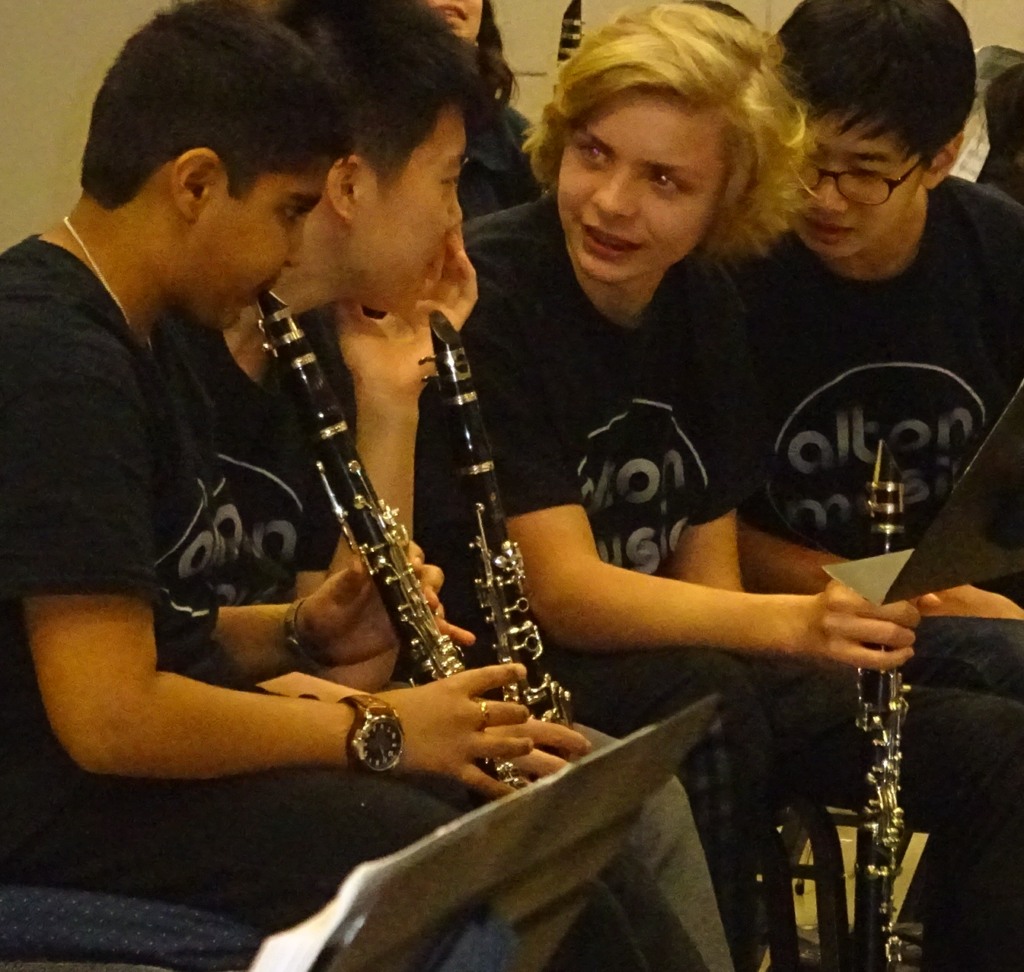 Social for sure – but no distancing. School is not going to be the same. To support meaningful access to education, alternative learning approaches must be put in place for all exempted students – for example, correspondence, print, or broadcast media instruction that is based on the individual student’s needs and circumstances. Additional supports for parents should also be considered. Exempted students must be provided with a daily schedule or timetable in accordance with the 300-minute instructional day.
4. Protocols for Delivering Remote Learning
School boards must ensure that the delivery of remote learning includes the following elements:
Communication Processes
School boards must inform students and parents about remote learning requirements, including the process for exemption from synchronous learning, and expectations for student attendance and engagement.
School boards should clearly communicate a process whereby parents can inform the school of any issues that their child may be experiencing with remote learning, and provide steps that parents may take to resolve any issues.
Teachers should communicate with the principal, students, and parents a regular schedule of synchronous learning sessions that fulfills the minimum time requirements, as part of their remote learning timetable. Teachers should accommodate parents who request a meeting through other modes (e.g., by telephone, through a virtual platform) when an in-person meeting is not possible.
Differentiated Assessment and Instruction
Teachers should provide daily opportunities for each student to receive meaningful feedback.
The policy outlined in Growing Success: Assessment, Evaluation, and Reporting in Ontario Schools, 2010 continues to apply during periods of remote learning and teachers should employ assessment for, as, and of learning (including diagnostic, formative, and summative assessment), as required.
Teachers should provide differentiated support to all students, including English and French Language Learners, and students with special education needs who have an Individual Education Plan (IEP).
Supporting Students with Special Education Needs
Where appropriate, educators should provide more opportunities than the minimum requirements for synchronous learning for students with special education needs, based on their individual strengths and needs, and provide differentiated support and instruction.
Educators should continue to provide accommodations, modified expectations, and alternative programming to students with special education needs, as detailed in their IEPs. If it is not possible to meet a student’s needs through synchronous learning, educators and families will work together to find solutions.
School boards are encouraged to provide continued access to assistive technology, including Special Equipment Amount (SEA) equipment, where possible, to support students with special education needs as they participate in remote learning. In situations where access to assistive technology is not feasible, educators are expected to work with students and parents to determine workable solutions on an individual basis.
Student Attendance and Safety
Student attendance must be taken daily at the elementary level and per course at the secondary level. Principals must ensure that student attendance records are submitted and that a staff member is assigned to contact parents in the case of an unexpected absence, in accordance with school and board attendance protocols.
In cases where a student is unable to participate in a synchronous learning session – for example, their device may be shared with a parent in the home – teachers should be informed, and they should make curriculum and assessment accommodations on an individual basis.
Boards may review how attendance counsellors could be used to further support student attendance, engagement, and well-being.
Boards must ensure that teachers follow school board-established procedures related to online safety, privacy, and cyber security.
5. Access to Remote Learning Devices – such as Laptops or Tablets – and the Internet
School boards must work collaboratively with parents to ensure that all students have access to remote learning devices and the Internet during remote learning. School boards are expected to provide remote learning devices and Internet connectivity to students who do not otherwise have access to them, and to develop policies on how these resources will be allocated on an equitable basis.
In situations where students do not have access to remote learning devices or the Internet, and a school board is unable to provide this support, school boards should have a process in place to work collaboratively with students and parents to establish alternative arrangements on an individual basis.
School boards should also consider how to support students in Education and Community Partnership Programs (ECPPs), including students in youth justice ECPPs, where access to the Internet may not be available or may be restricted due to a court order.
Teachers should work from a school or board facility during remote learning, where possible, with reasonable accommodations if required. If this is not possible, teachers should maintain regular communication with the principal. School boards should support educators in accessing remote learning devices and tools to support remote and synchronous instruction.
6. Standardized Suite of Synchronous Learning Platforms
School boards must provide teachers with a standardized suite of synchronous learning platforms to ensure that students have a consistent learning experience, and provide teachers with training on these platforms. The platforms will allow real-time communication between educators, students, and parents during remote learning.
Synchronous learning platforms should include live video, audio, and chat features and be fully accessible. To support student safety and well-being, school boards should consider providing a tool that allows educators to control student microphones and cameras. School boards may also wish to consider synchronous learning platforms that include virtual whiteboards, recording features, participant polling features, and file uploading and sharing features.
7. Cyber Security, Privacy, and Online Safety
Ensuring the protection of privacy and the cyber security of educators, students, and parents is paramount to supporting a safe and inclusive learning environment for remote learning.
School boards must review their cyber security and privacy policies, and develop updates related to remote learning. These policies must include clear protocols and procedures for educators to follow so that they can ensure student safety and security during remote learning. These protocols must be clearly communicated to educators, students, and parents.
Board protocols should ensure that students and educators do not share passwords, that student initials are used for account creation instead of full names, that teachers are the last ones to leave synchronous learning sessions, and that students and teachers are aware of and respect board policies regarding digital conduct and privacy.
School boards should provide professional resources to all school staff to increase cyber security awareness.
Effective Practices
To support students and educators during periods of remote learning, school boards should develop effective practices, including:
providing technical support for remote learning
providing educator training
using standardized platforms
setting out roles and responsibilities
1. Providing Technical Support for Remote Learning
School boards should provide technical support to educators, students, and parents for the use of board-provided devices and access to the Internet during remote learning.
Technical support should be responsive to immediate needs. It should assist users who have specific technological problems and questions. In the context of remote learning, technical support should span the full spectrum of users’ technological needs, including devices, connectivity, security, and digital learning tools and applications.
Board staff, educators, students, and parents should know where to seek help when they encounter technical issues during remote learning. School boards should provide clear information on who can provide help (e.g., board staff, service providers), and how users can access that help (e.g., by email, telephone).
2. Providing Educator Training
Educators should have access to subject- and division-specific training to support remote learning.
School boards should deliver remote learning strategies and educator training related to:
student and staff safety;
student and parent comfort levels with technology, and the levels of support that may be required;
effective use of digital tools;
effective pedagogy and assessment;
student and staff mental health and well-being;
accessibility and differentiated instruction for all students, including students with special education needs.
3. Using Standardized Platforms
Educators should use board-approved synchronous learning platforms that are fully accessible.
Principals should ensure that educators have access to a suite of appropriate technology products, tools, and resources to support the delivery of remote learning. To ensure that students have a consistent learning experience, the maximum number of synchronous learning platforms used within a school should be three, where possible.
4. Setting Out Roles and Responsibilities
School boards should consider the rights and responsibilities of students, parents, teachers, educational assistants, early childhood educators, and other school and board staff during remote learning.
Teachers are expected to carry out the instructional duties assigned to them by their principals and to comply with all professional standards and obligations under the Education Act and the Ontario College of Teachers Act, 1996. These include having responsibility for the effective instruction and evaluation of the progress of students in the subjects and classes assigned by the principal (including by electronic means), preparing and submitting lesson plans to the principal, and communicating regularly with parents.
Technology Enabled Learning and Teaching (TELT) contacts at each school board can play an active role in supporting communication of the policy, educator training, and implementation of remote and synchronous learning. For example, they can support the use of the ministry’s Virtual Learning Environment, which provides educators with training related to digital learning tools.
Implementation
School boards must ensure that the requirements outlined in this memorandum are implemented by the beginning of the 2020-21 school year.
School boards are encouraged to consider local needs and circumstances, and to consult with local partners in their implementation of remote learning. In the French-language education system, the implementation of remote and synchronous learning should take into account Ontario’s aménagement linguistique policy and support the vitality of the French-language culture in a minority setting.
Monitoring and Evaluation
School boards are required to report at the end of the school year on their activities to fulfill the direction outlined in this memorandum.
School boards are expected to develop and implement a process for regular data collection, and to collect data related, but not limited, to:
areas in which educators require additional support in implementing remote learning, including providing student and educator access to technology and the Internet;
strategies to provide training related to the identified areas of need, including learning and well-being;
details of implementation progress and monitoring activities, including the number of exemptions from synchronous learning and what alternative approaches were used;
parent and student feedback on the impact of remote learning, including:
level of student engagement in learning;
ease of online learning participation;
access to teachers;
ease and access to technology;
information on how parent and student feedback is being taken into account in the delivery of remote learning.
Data covering the school year must be provided to the ministry no later than July 31 of each year in which there are periods of remote learning.
School boards are expected to make adjustments to their implementation of the requirements in this memorandum based on parent, student, and staff feedback collected throughout the school year.
Upon request of the ministry, school boards may be required to report on the following data during the school year:
for any given calendar month, the number of students engaged in remote learning;
for any given calendar month, the number of students provided with the minimum requirements for synchronous learning;
for any given calendar month, the number of students exempted from the minimum requirements for synchronous learning.
1 In this memorandum, unless otherwise stated, student(s) includes children in Kindergarten and students in Grades 1 to 12.
2 In this memorandum school board(s) and board(s) refer to district school boards, school authorities, and Provincial and Demonstration Schools (including the schools operated by the Centre Jules-Léger Consortium).
3 In this memorandum, parent(s) refers to parent(s) and guardian(s).

 By Pepper Parr By Pepper Parr
August 13th, 2020
BURLINGTON, ON
This afternoon and probably well into the evening the Standing Committee on Corporate Service debated a change to the way council meets.
While operating under the rules put in place during the Emergency council was permitted to meet virtually which isn’t quite the same as meeting in city hall council chambers where we can see the members of council and catch the interplay between council and staff.
A staff report from the City Clerk would like Council to approve the amendment to Procedure By-law 04-2020, as amended to allow for electronic meetings to occur without a declaration of an emergency.
This report is supposed to be about: Building more citizen engagement, community health and culture
Background and Discussion:
In response to the COVID-19 virus, in March 2020 the City of Burlington closed all city facilities including city hall to public access. Over the following months the city had to shift much of its workforce to work remotely. As the city continues to operate, meetings must occur to ensure that the necessary approvals are obtained. At present the City of Burlington is slowly bringing in-person services back online.
March 16, 2020 – All city facilities, including city hall, were closed to the public. It was determined that all meetings during a three-week period would be cancelled including the regularly scheduled March City Council meeting.
March 19, 2020 – Ontario legislature passed Bill 187, the Municipal Emergency Act, 2020, to enable municipalities, during a declared emergency, the ability to allow for virtual participation, and to conduct Council meetings electronically with members who participate remotely being counted for the purpose of quorum.
March 24, 2020 – Special Council meeting held to enact necessary Procedure By-law amendments to allow remote participation. A meeting guide was posted to the city’s website which provides additional information on how virtual meetings will occur.
April 20, 2020 – Procedure By-law amendments to enable virtual delegations and to re-establish Committee of the Whole to allow for the city to be nimble when agenda planning.
May 25, 2020 – Proposed path forward to allow for statutory public meetings in accordance with the Planning Act R.S.O. 1990, and the addition of an August cycle of committee meetings.
July 21, 2020 – Ontario legislature passed Bill 197, the COVID-19 Economic Recovery Act, 2020, which allows for electronic meetings beyond a declared emergency, and proxy voting at Council.
During this time the Province has provided municipalities a framework for local councils to meet virtually. Based on the experience over the past months, Council and committee meetings may be required to be conducted virtually for some time.
On July 24, 2020, the Region of Halton moved into Stage 3 of Phase 2 of recovery. At the time of preparing this report, staff are seeking clarification on the indoor gathering sizes.
Should there be a change to public health guidelines and indoor gathering sizes, accommodations to the physical set up of Council Chambers may be introduced, based on advice from Halton Public Health and the City of Burlington’s facilities, and health and safety teams.
This is the point at which the Staff report should have ended.
The report goes on to say and suggest that the amendments afford local councils the ability to pass amendments to their procedure by-law to allow remote participation beyond a declared emergency and introduce the concept of proxy voting at council meetings.
If you give them the right to shut things down significantly and limit real public participation – they will use it.
In the report we are told that: “Bill 197 – the COVID-19 Economic Recovery Act, 2020 On July 21, 2020 Bill 197 the COVID-19 Economic Recovery Act, 2020 received royal assent. Bill 197 was an omnibus bill and contained several amendments to various acts. Amendments to the Municipal Act are contained in schedule 12 and focus on council procedure matters. The amendments afford local councils the ability to pass amendments to their procedure by-law to allow remote participation beyond a declared emergency and introduce the concept of proxy voting at council meetings.
Staff are recommending to amend the City of Burlington Procedure By-law to allow for remote participation at Council meetings after a declared emergency. Supporting the amendments would afford the municipality with additional flexibility when determining whether to maintain a declaration of an emergency.
These amendments will also be extended to standing committees and advisory committees of Council.
Council should be aware that once the declaration is lifted, all previous notice provisions for City Council are reinstated. The clerks department will work with staff to ensure that special meetings adhere to the 72-hour notice requirement.
Schedule 12 also introduced the ability for a municipality to pass procedure by-law amendments to afford for proxy voting at Council meetings. An excerpt of Schedule 12 related to proxy voting is provided as Appendix B which we will publish as a seperate article and link it to this article.
At this time an amendments package has not been provided to Council. Staff require additional time to review the legislation and recommend a path forward to Council.
During this time, staff will monitor other municipal units and their respective Councils to better understand how the legislation is used and the proxy voting rules implemented. There may be a benefit to allowing for proxy voting if a second or third wave to the pandemic occurs, the ability to use proxies may allow for greater flexibility to Council members. Advisory Committee Meetings During the past few months, staff took the time to refine the remote Council and standing committee processes. In addition, some City of Burlington advisory committees have also met virtually:
Audit Committee – June 10, 2020 (standing committee with members of the public) •
Committee of Adjustment – July 15, 2020 CoA met twice each week for a period of time to get caught up on the variance applications. Those meetings went well.
Burlington Downtown Parking Advisory Committee – July 21, 2020
The balance of the committees will resume in September with the caveat that they will only convene to provide input on city business, or staff reports. The clerks department will work with the staff committee liaison, and the advisory committee chairs to ensure that this balance is achieved. Narrowing the scope will ensure that when the committees meet, they focus on advancing municipal business. It has been observed that virtual/remote meetings take longer than in-person meetings and require additional support to run. Residents may tune into the meeting by way of a weblink. Individuals who wish to delegate are able to submit a request by way of the clerks department.
The rules as established by the remote participation guide will apply. For reference, an excerpt of the remote participation guide regarding public participation will be provided as a seperate piece that will be linked to this article.
The advisory committee review is in process. At the April 20, 2020 Council meeting substantive direction was provided to staff. It is anticipated that initial pieces of the review will be brought forward in the fall, along with a schedule of when the balance of the staff direction deliverables may be presented.
Strategy/process
With the current situation presented by COVID-19 and the public health recommendations to physically distance, holding in-person committee and Council meetings have become a challenge. With the recent amendments to the Municipal Act, by way of the Municipal Emergency Act 2020, and the COVID-19 Economic Recovery Act, 2020, regarding remote participation at Council and committees of Council has allowed for City of Burlington business to continue. Staff are currently leveraging technology to ensure that the advisory committees will be brought online in September.
Options Considered
Other models or combinations of participation were discussed at length. (Who took part in those discussions? Just the bureaucrats and maybe a couple of Councillors?)
Staff will continue to monitor public health, in terms of indoor gathering sizes and best practices. Should there be a change in how Council meetings are physically set up, staff will advise Council and the general public through the communications department. Any changes must be in lockstep with advice from Halton Public Health and upon the review of plans by the City of Burlington facilities, and health and safety teams.
The cost amounts to acquiring a Zoom license. Planning acquired their own Zoom license to ensure that there is no overlap of meetings, as one license can only conduct one meeting at a time.
There is no reason at this point in time to move on the report recommendations.
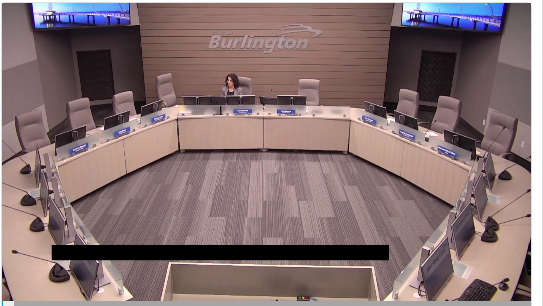 Sometime in November, assuming the infection numbers remain low (the colder weather may bring on an increase – we just don’t know yet) Council should be able to resume normal meeting set ups. There is more than enough room to spread them out around the horse shoe and put staff further back in the Chamber and provide just two rows of seats for the public and keep spaces of at least six feet between participants. Sometime in November, assuming the infection numbers remain low (the colder weather may bring on an increase – we just don’t know yet) Council should be able to resume normal meeting set ups. There is more than enough room to spread them out around the horse shoe and put staff further back in the Chamber and provide just two rows of seats for the public and keep spaces of at least six feet between participants.
It can be done – all it takes is a will on the part of the administration with strong direction from Council.
The Gazette’s assumption is that those elected really want the electors to be in the room.

 By Staff By Staff
August 13th, 2020
BURLINGTON, ON
City Council does have to come up with a budget before the end of the year.
The Province of Ontario announced as part of the federal-provincial Safe Restart Agreement that the City of Burlington will receive $4,470,700 to support municipal operating pressures for Phase 1 and Burlington Transit will receive $1,571,213 to support municipal transit systems for Phase 1.
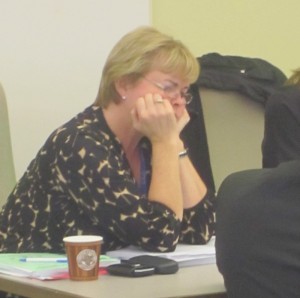 Joan Ford, the city’s Director of Finance doesn’t have to worry as much about where the money to pay the bills is going to come from. Senior City staff will be presenting the monthly COVID-19 verbal update to the Corporate Services, Strategy, Risk and Accountability Committee Meeting on Thursday.
At the last monthly update to Burlington City Council on July 9, the City was estimating revenue losses of $18 million. The City was able to mitigate $9.9 million for a projected year end shortfall of $8.1 million before needing to draw from reserve funds.
If memory serves us correctly the shortfall was in the $4 million range
Municipalities will be provided with up to $1.6 billion as part of the first round of emergency funding under the Safe Restart Agreement.
This funding will help municipalities like Burlington protect the health and well-being of residents, while continuing to deliver critical public services to our community and assist with economic recovery.
Through the Safe Restart Agreement with the federal government, $695 million will help municipalities address operating pressures related to the COVID-19 pandemic through the first round of emergency funding, and over $660 million will support transit systems. The province is also providing an additional $212 million through the Social Services Relief Fund to help vulnerable people find shelter.
 There will be money for the transit service – will there be passengers willing to ride the buses – especially if they are crowded. In addition to the support for municipalities, the government is providing over $660 million in the first phase of transit funding to the 110 municipalities with transit systems. The funding can be used to provide immediate relief from transit pressures, such as lower ridership, as well as for new costs due to COVID-19, such as enhanced cleaning and masks for staff.
In the second phase, additional allocations will be provided based on expenses incurred to ensure the funding meets the needs of municipalities. As part of the Safe Restart Agreement with the federal government, up to $2 billion is being provided to support public transit in Ontario.
Mayor Marianne Meed Ward said: “This is exactly the support we need from our upper levels of government to continue to provide the services our residents need, in the midst of COVID-19. Today’s funding announcement for Burlington will allow us to continue to serve our community without service cuts, unacceptable tax increases or depleting reserves.

 By Staff By Staff
August 13th, 2020
BURLINGTON,ON
Robin Bailey, Executive Director of the Burlington Food Bank, does a two-minute You Tube broadcast almost every day of the week to talk about the things people have to do to stay healthy – Eating the right kind of food regularly has been his theme for the past month.
Robin is in the food business – collecting it through donations and buying whatever is not donated so that the people in Burlington who need food have a place to go.
There are a lot of people not able to work due to COVID. Those who are self-isolating need someone to go out and buy food for then or have food delivered to them.
Robin is on the delivery side of that equation.
 Cookie treat from the Wellington Square Meals program to the volunteers at the Food Bank Bailey points out that “One of the adverse effects of the covid crisis is the financial stress that most of us are feeling and that’s not good for your body overall. We need to eat healthy right now and we are proud to be able to produce and provide fresh healthy food choices. We receive fresh produce from our garden and from the community as well as purchasing fresh food. We also have protein options we can add to your support. Stress causes us to make unhealthy choices and financial stress may cause you to skip meals so we try to get everyone to ask for the support they need.”
Some of that food, not necessarily healthy got delivered to the Food Bank from one of their clients – the Wellington Square Meals program sent over small cookie bags to thank the Food Bank for their support.
“If you are in need or know of someone who could use our help PLEASE have them email us at info@burlingtonfoodbank.ca or call 905-637-2273 to make arrangements to have food dropped at their door or they can now pick it up. If you live in Burlington, we are here to help.”

 By Staff By Staff
August 12th, 2020
BURLINGTON, ON
The Halton Regional Police Service – Drug and Human Trafficking Unit has concluded an investigation into an incident that occurred at a Burlington hotel in July, 2020.
Two females (ages 16 and 18) were identified as victims of human trafficking as a result of the investigation. The Halton Regional Police Service, with assistance from the Barrie Police Service, has since arrested two males in relation to the incident.
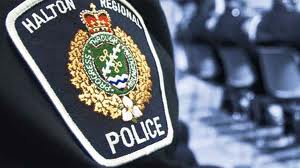 Charged are: Charged are:
Kevaun Orlando Parkes (22) of Brampton
• Trafficking in Persons – Child
• Material Benefit – Trafficking in Persons – Child
• Material Benefit – Purchasing Offence – Child
• Knowingly Advertise for Sexual Services x2
• Trafficking in Persons – Adult
• Material Benefit – Trafficking in Persons – Adult
• Material Benefit – Purchasing Offence – Adult
• Withhold or Destroy Identity Document – Adult
• Assault
• Procuring – Child
A youth offender (male) from Brampton has been charged with:
• Trafficking in Persons – Child
• Material Benefit – Trafficking in Persons – Child
• Material Benefit – Purchasing Offence – Child
• Knowingly Advertise for Sexual Services x2
• Trafficking in Persons – Adult
• Material Benefit – Trafficking in Persons – Adult
• Material Benefit – Purchasing Offence – Adult
• Procuring – Child
Both parties were held in custody pending a bail hearing.
Police believe there may be further victims. Anyone with information is asked to contact Detective Dan Ciardullo of the Drug and Human Trafficking Unit at 905-825-4747 ext 4973.
Tips can also be submitted anonymously to Crime Stoppers “See something? Hear something? Know something? Contact Crime Stoppers at 1-800-222-8477 (TIPS) or through the web at www.haltoncrimestoppers.ca.
The Halton Regional Police Service is a member of the Halton Collaborative Against Human Trafficking along with several other stakeholders and agencies. This Collaborative is dedicated towards providing services and support to those who have experienced Human Trafficking in Halton and surrounding regions. Local organizations such as “SAVIS” (www.savisofhalton.org) are able to provide first response care and support to victims of human trafficking.

 By Pepper Parr By Pepper Parr
August 12th, 2020
BURLINGTON, ON
It was pathetic.
The media release was from the Office of the Mayor. She was exited about the change in the name of a committee that is part of AMO – Association of Municipalities in Ontario,
Mayor Marianne Meed Ward was acclaimed recently as a member of LUMCO – Large Urban Mayors’ Caucus of Ontario
They recently changed their named to Ontario’s Big City Mayors and that was important enough to put out a media release.
Really?
“LUMCO is excited to announce its new name: Ontario’s Big City Mayors (OBCM). While the name has changed, our mission remains the same: to represent the interests of Ontario’s 29 biggest cities, and almost 70% of Ontarians, through public policy development, advocacy and discussion.
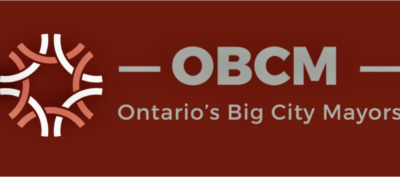 “Ontario’s Big City Mayors (OBCM) is comprised of mayors of Ontario cities with populations of 100,000 or more. “Ontario’s Big City Mayors (OBCM) is comprised of mayors of Ontario cities with populations of 100,000 or more.
“OBCM provides a voice for big city mayors in policy debates that impact Ontario cities. Through policy development, advocacy, discussion and partnerships, Ontario’s Big City Mayors support strong and effective cities.”
The Mayor and two of her Council members did themselves proud earlier this week last week when they “took a knee” at the Black Lives Matter graphic painted on the sidewalk outside city hall.
 Thousands of young people marched on city hall to show their support for the Black Lives Matter movement. 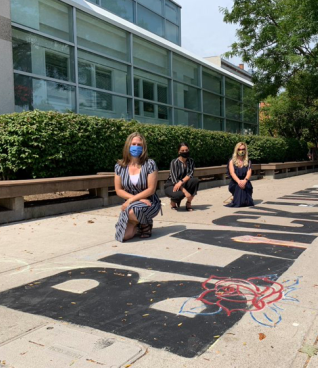 The Mayor and two Councillors did the “taking a knee” gesture beside the Black Lives Matter outside city hall. The graphic had relevance – especially after the march of several thousand people who demonstrated outside city hall a number of months ago.
But “taking a knee”? That is a gesture we see at sports events in the United States where people of colour in the sports sector have been poorly treated for decades.
“Taking a knee” in that venue makes sense and has an impact.
In Burlington a passer-by might well ask: ‘What are they doing’?

 By Staff By Staff
August 12th, 2020
BURLINGTON, ON
The wearing of face coverings/masks is known to pose a significant barrier to the Deaf community, as masks make it harder to lip read and understand sign language.
To better serve the demographics of our community, while continuing to mitigate the transmission of COVID-19, Halton Regional Police Service officers are now equipped with ClearMasks™.
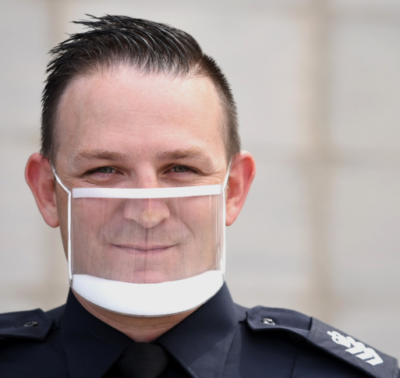 “Our ability to communicate with the members of our community is absolutely essential,” says Halton Regional Police Service Deputy Chief Roger Wilkie. “With guidance and input from the Bob Rumball Canadian Centre of Excellence for the Deaf, we have now removed a significant communications barrier.” “Our ability to communicate with the members of our community is absolutely essential,” says Halton Regional Police Service Deputy Chief Roger Wilkie. “With guidance and input from the Bob Rumball Canadian Centre of Excellence for the Deaf, we have now removed a significant communications barrier.”
“By introducing ClearMasksTM within Halton Regional Police Service, anyone from the Deaf community can now have more accessible dialogue with police officers,” says Jayne Leang, Director of Business Relations at the Bob Rumball Canadian Centre of Excellence for the Deaf.
“In an emergency situation, allowing a person who is Deaf or hard-of-hearing the opportunity to see the officer’s facial expression or attempt to read their lips, helps in the exchange of potentially life-saving information.”
These Health Canada-approved masks feature a transparent window, allowing the mouth to be fully protected, while fully visible, for those who use speech reading, lip reading or who are profoundly deaf and use American Sign Language, which is heavily dependent on facial expressions

 By Staff By Staff
August 12th, 2020
BURLINGTON, ON
They are at it again – cars being towed from the No Frills Plaza on Brant Street.
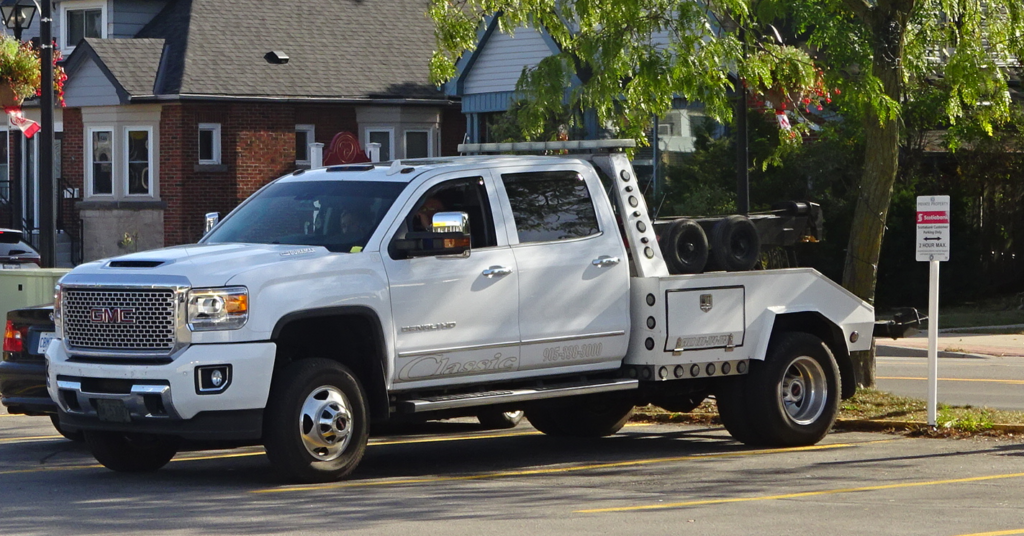 They lie in wait at the entrance to the parking lot. They lie in wait – watching people drive in, do some shopping and then leave the parking lot on Brant to do other errands.
The moment the tow truck driver sees the person leave the parking lot they swoop in and put the hook on the vehicle and take it off to the pound. $300 will get it back.
A Burlington resident who lives in a unit that has a clear line of site to the parking lot wrote the Mayor.
Good day Ms Mayor,
I live above the No Frills parking lot on Brant Street. I sit on my deck and watch cars being towed every day out of the No Frills lot.
I do understand that there is signage but it’s not very visible. I watch families park and go to the Dollar store, then No Frills and then walk off the lot and they’re towed instantly.
My concern is that the signs are not big enough, not prominent enough.
I believe in this climate when people are broke and desperate enough to shop at the Dollar store that we shouldn’t apply parking penalties that are over 300 dollars.
The parking lot is empty these days, it’s not about space, it’s about greed and it really breaks my heart. Please help.
I saw 8 cars towed between 4:30pm and 730pm today Tuesday August 11th.
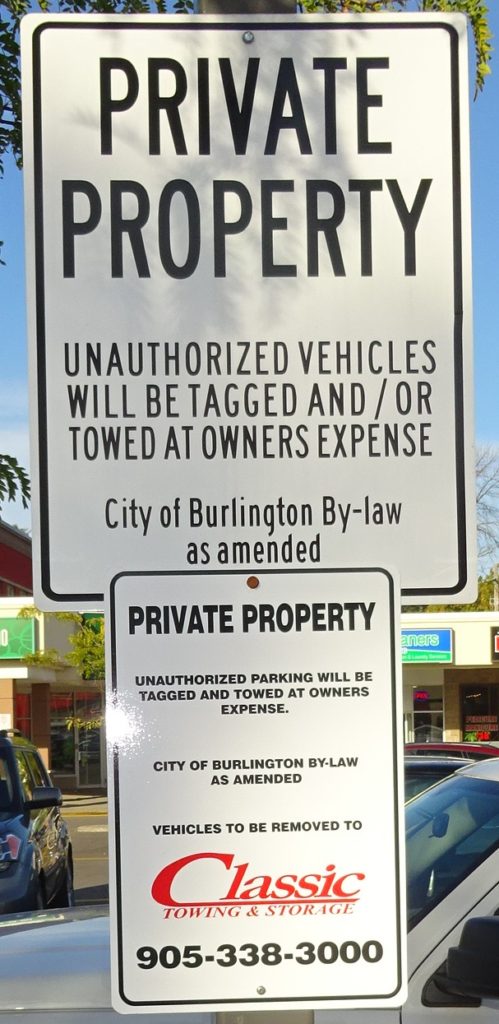 The signs are clear – and they are not small. The signs are very clear in the parking lot. And there is public parking yards away. And there is a lot of space in the parking lot.
The towing company that has the contract acts on instructions from the owners of the property.
Greed could well be the driving force. Getting tired of people not bothering to read the No Parking Signs and taking advantage of the available space could have made the owners decide it is time to crack down.
Will a call from the Mayor do any good? Not really – the parking offenders have to be more careful and the property owners might think in terms of being a little charitable.
Times are tough for a lot of people – except for the tow truck drivers who take great delight in hooking up a truck. I’ve watched them.

Delegating before city council is both a tradition and an important part of citizens getting their views before those elected to guide the city and direct the administration on what they want done.
Burlington has some fine delegators; people who do their homework and believe their role is to hold city council accountable. Yesterday Hunter Lawson delegated on the plans the Region of Halton has for the updating of its Official Plan.
Lawson delegated several hours before Curt Benson, Planner for the Region, talked about the five Discussion papers the Region has prepared. Benson referred to the Lawson delegation several times during the long explanation he gave members of Council. Hunter Lawson had been heard and Curt Benson had listened.
Lawson now gives his opinion on what public engagement is all about.
 By Lawson Hunter By Lawson Hunter
August 12th, 2020
BURLINGTON, ON
Halton Regional Council held a workshop on July 8th and a Council Meeting on July 15th to deal with the Region’s upcoming Official Plan Review (ROPR) and how it relates to Planning changes recently made by the Province through the Greenbelt Plan, the Growth Plan and the Provincial Policy Statement.
A City’s Official Plan must conform to the Region’s Official Plan which must conform to several Provincial Bills and Regulations. Over the past two years, the Provincial government has been busy making drastic amendments to Provincial Plans and the Provincial Policy Statement. This is why the citizens of Burlington must be informed and engaged.
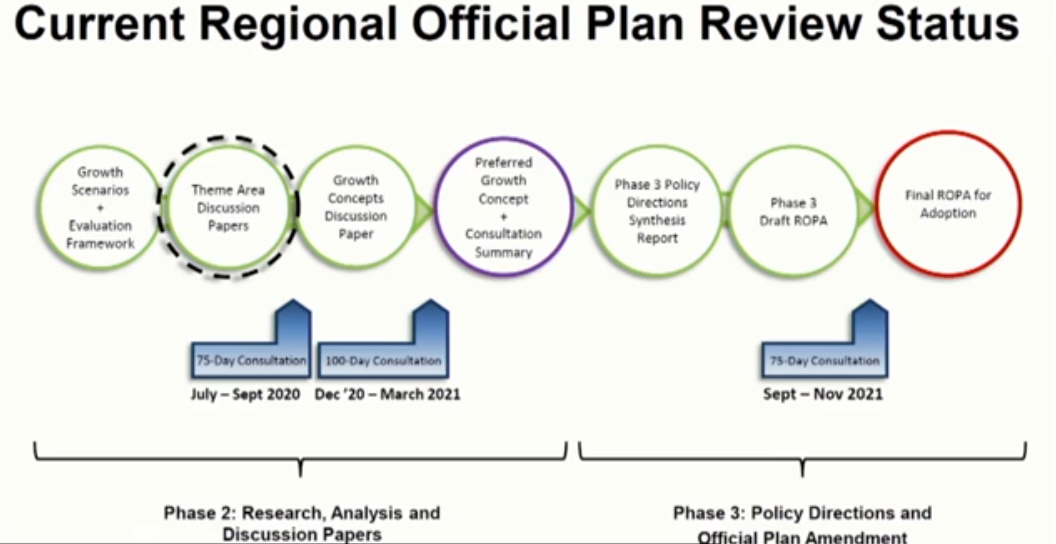
Five Discussion Papers were drawn up that form the key themes of the Regional Official Plan Review:
Climate Change;
Natural Heritage;
Rural and Agricultural System;
Regional Urban Structure; and
North Aldershot Planning Area.
I delegated to Council to urge them to go beyond what the Region has planned for Public Engagement. From what I can gather, it is limited to the an online survey and one or two Public Information Centres, which will be difficult given our challenges with social distancing due to coronavirus. I propose that the City of Burlington hold its own Public Engagement strategy to inform the public of the importance of the Regional Official Plan as it relates not only to Land Use but to the Climate Emergency that this Council has declared. We need a ‘made in Burlington’ engagement plan. (Note: Curt Benson, Director of Planning Services at the Region, later told Council that there would be 4 PICs)
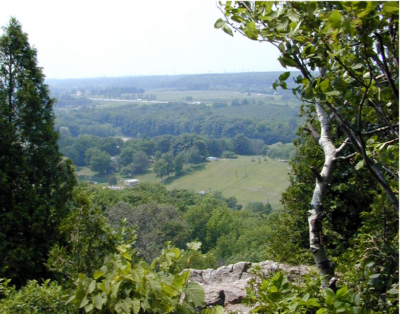 Though the Regional Official Plan is not slated to be finalized until Q4 2021, and the Region has hinted that Public Engagement will be undertaken – my concern centres on the fact that public engagement was slated to run from July 15th to Sept. 28th. Summer months are well known to be a slow time to engage the public. The time between July 15th, the day that Regional Council accepted the Discussion Papers, and July 29th, the day that public notice was sent of a request for comments, is a concern. The next Regional Council meeting will be Sept. 16th, when it’s expected Council will discuss public feedback, which is twelve days before the public engagement period ends. Neither inspires confidence that public engagement will be full and effective. (Note: Benson later told Council that Regional Staff would require considerable time to evaluate and prepare a report for Council’s review) Though the Regional Official Plan is not slated to be finalized until Q4 2021, and the Region has hinted that Public Engagement will be undertaken – my concern centres on the fact that public engagement was slated to run from July 15th to Sept. 28th. Summer months are well known to be a slow time to engage the public. The time between July 15th, the day that Regional Council accepted the Discussion Papers, and July 29th, the day that public notice was sent of a request for comments, is a concern. The next Regional Council meeting will be Sept. 16th, when it’s expected Council will discuss public feedback, which is twelve days before the public engagement period ends. Neither inspires confidence that public engagement will be full and effective. (Note: Benson later told Council that Regional Staff would require considerable time to evaluate and prepare a report for Council’s review)
Public engagement is also noted for Phase 3 of the process but by that time Regional staff will have prepared ‘preferred options’ which will limit public discussion, as we have seen over and over again – a public display of an either/or choice or worse, “adopt this or nothing”.
In comparison, the City of Burlington has held extensive public engagement regarding the City’s ‘Adopted Official Plan’ and specifically the ‘Taking a Closer Look at Downtown’. Surveys (online and paper); 7 Citizen Action Labs; 17 pop-up events; outreach to 130 students and the Burlington Youth Council and the Halton Multicultural Council; walking tours; 3 drop-in sessions; and an upcoming online Town Hall on Aug. 18th. An unprecedented amount of effort.
 Scoped Review of the Downtown portion of the affirmed but not yet adopted Official Plan So I must ask, “Is Downtown Burlington more important than North Aldershot, the Rural and Agricultural System, Climate Change?” Each of the five topics that the Region is seeking public comment on is important in its own right. How much emphasis does the Region and the City place on these planning issues?
The timing of public engagement needs to be pushed back into the Fall to allow for a comprehensive process and full disclosure so that residents can digest, and discuss among themselves, the various reports, some of which are longer than 100 pages.
If the Region is not prepared to do this, then the City of Burlington must insist on these changes so that at least Burlington is prepared to look into the future and make its own Official Plan the best that it can be.
A municipal Official Plan does not inspire most residents to take notice. Despite the endless discussions this Council has had on its ‘Adopted Official Plan’, most Burlington citizens, outside of a few committed downtown residents, have only a vague notion of the significance an Official Plan has on how this city will look and operate for decades to come.
We need the Province to hear more than just a nice letter stating that the Region is discussing Climate Change and Natural Heritage and the rest. Each deserves comprehensive public engagement not only with ‘stakeholders’ but with the public that will be affected by those issues and by the Province’s changes to Plans such as the Growth Plan and the Greenbelt Plan, to specific topics such as lessening Environmental Assessments and removing restrictions that protect Endangered Species and eliminating zoning designations.
This is, perhaps, our best chance to let the Provincial government know exactly how we feel about those changes and how we want our city and region to look, feel, and develop for our children and future generations.
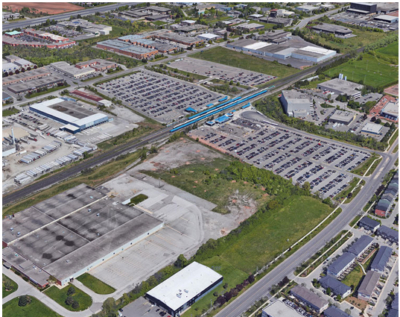 Appleby GO station – one of the hubs (now called MTSA’s) – Major Transit Service Area – where the city wants intensive development to take place. Think in terms of concentrations of apartments I’m sure someone will note that it is the traditional practice of the Province to allow public feedback through letters, online postings or the Environmental Registry. But, you also have to admit that several of these changes were made under the cover of the COVID crisis, behind a wall of secrecy or hidden within some omnibus bill.
This is our chance to be heard. Public Engagement needs to reach the highest level we have ever known in this community. We need to pull out all the stops, educate, explain and underscore that changes to legislation and the Official Plan will have a major impact on our community for the next 30 years.
The Official Plan is the most significant tool that a city has to influence how neighbourhoods will look. How and where parks and amenities are located. What mixture of high, low and mid-level housing will be allowed. What transit and transportation methods will have priority. Where and what kind of development will be permitted – rural or urban, greenfield or intensification. Will we have walkable, complete streets or continue to bow to the car culture? Where and what kind of industry and business will be located in appropriate areas?
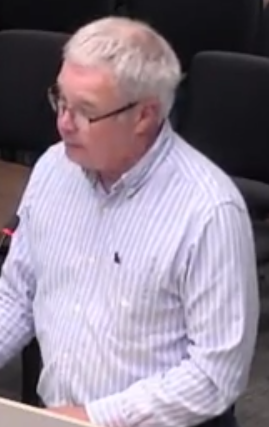 Lawson Hunter All of these things, and more, affect our promise to reduce GHG emissions over that same 30 years. The Land Use policies ‘we’ decide to enshrine will ensure that our air is clean, our neighbourhoods are livable, that we can accept the influx of new residents that we know are coming, 1.1 million residents in Halton by 2051, depending on whose forecasts you choose to accept.
Public Engagement, if done right, represents an unparalleled opportunity to discover what the public really wants our city, region and planet to look like – now and in the future.
Does that not require an extensive, well-funded and timely occasion to inform and listen to what the majority of citizens want?

 By Pepper Parr By Pepper Parr
August 11th, 2020
BURLINGTON, ON
It was the end of a long week – with the week ahead not looking all that much better.
 Director of Education Stuart Miller is being pressed on all sides – the situation he faces is far more challenging that the closure of two high schools. Stuart Miller and his team are bushed. They have been given their marching orders by the province; they now have to make it happen with what they have.
Every elementary student will be in their home classroom – teachers will come to them; the students will take recess and lunch together and not mix or mingle with other students. In some grades they will be asked to wear masks.
There are likely to be some classes that will have in excess of 25 students – some report that there will be classes with 30 students – when you add the teacher and the EA that is a pretty full room making it difficult to stick to the six foot apart rule.
It is going to be a challenge to keep the different classes apart come recess and lunch – a scheduling nightmare.
The secondary students will do a day in a classroom – just 15 in the class, the following day they will work from hone on-line where they will be taught synchronously by their teacher.
Parents who are concerned about the safety of their children, teachers who are apprehensive and an HR department that needs to make sure they have access to supply teachers who may have to replace classroom teachers who decide they do not want to be in classrooms.
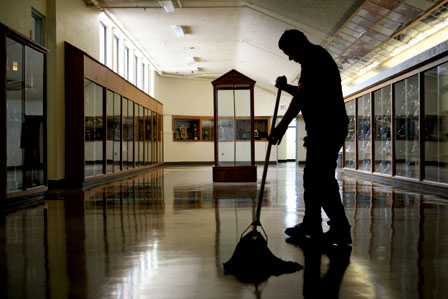 The clean ups at every school will be very through and very frequent. Custodial people have to be hired as well.
The teachers were sent a 79 page document setting out the way the school board administration expects things to work in a situation that is both dynamic and fluid.
Parents will be getting a document with much of the same information on Monday and are asked to let the Board of Education know what they plan to do with their children.
“Some parents won’t get back to us” said Miller. “We will have principals at the schools calling those parents to find out what they want to do.
“We also have number of households who have more than one student going to high school. That will mean each student having access to a laptop computer which for some families may not be in their budget.
The Board will ensure that everyone has what they need to be able to take part on those half days when high school students are being taught synchronously as a class on-line.
There will also be some students who will attend a class within the school due to limitations they have with on-line learning.
The teachers doing the online teaching will do so from the schools – perhaps not from the actual classroom but their base will be the school.
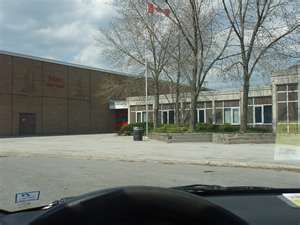 The upgrade at Nelson high school meant to accommodate the students transferring out of Bateman has been delayed – keeping students in their old school. Delays at Nelson high school where additions are underway to accommodate the transfer of students from Bateman high school to Nelson – with Bateman to be closed at some future date – will be delayed due to construction issues that resulted from the shutdown of the site when a worker was tested positive.
The province has budgeted for some 500 nurses who will be available to schools. With 105 schools in the Region and 44 School Districts in the province those nurses are going to be stretched pretty thin.
Exactly what the nurses are going to do is not clear. What is clear to Miller is that he has an excellent working relationship with the Medical Officer of Health, (MOH) Dr Hamid Megani. All the bases will be covered.
The overriding concern is having a procedure in place for those schools where a hot spot turns up. The Board wants to be able to move quickly and isolate any outbreak and ensure that if there is one it is limited to a classroom and not school.
Everyone is working full out on ensuring that they get it right the first time.
Miller, who has been an educator for more than 35 years, said that what he is going through now “is not something they taught us in principal school.”
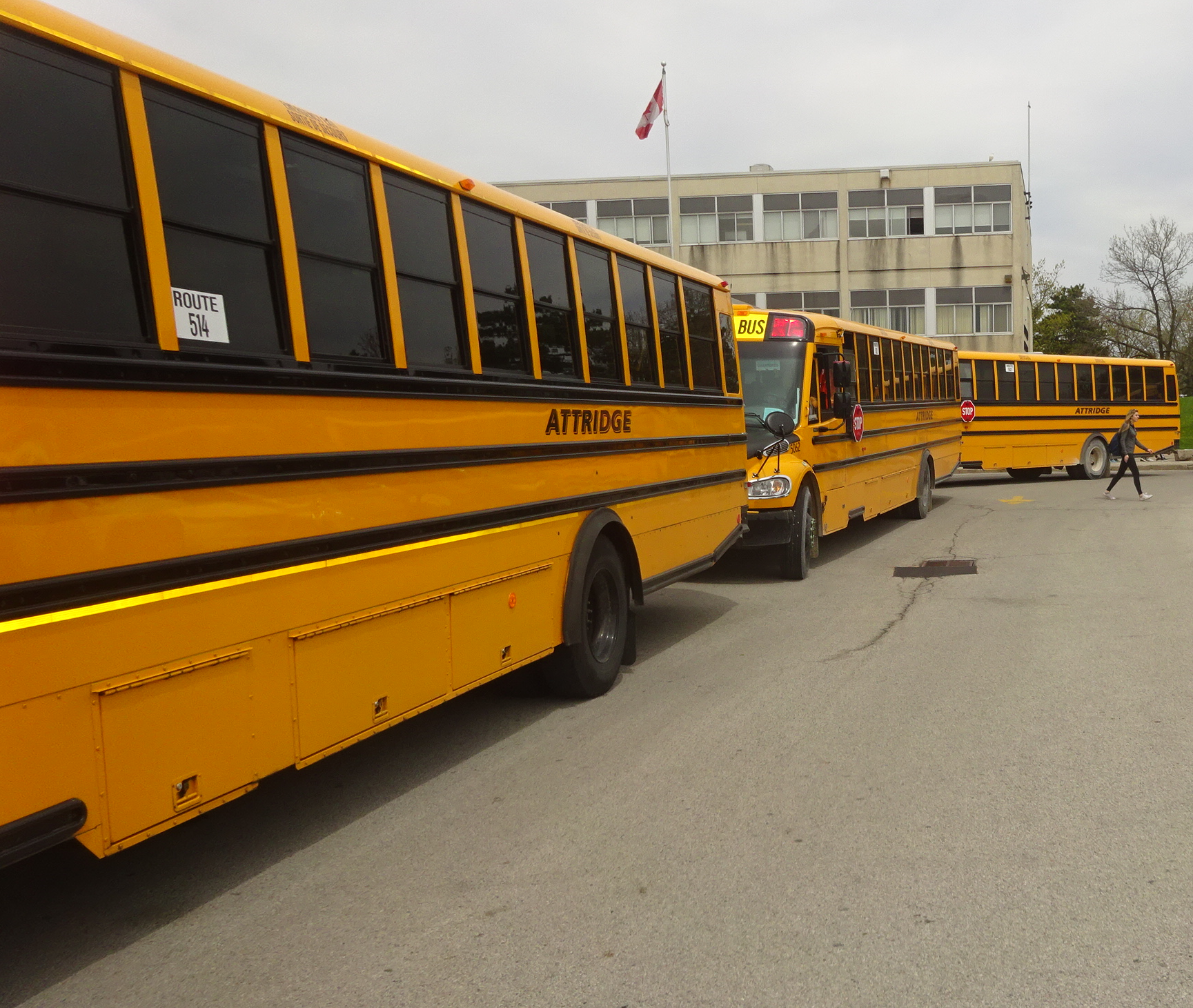 How many students in each bus – are there enough buses? Getting the students to school is another challenge that is being worked on. How many children will be permitted on each bus – will there be enough bus drivers. And how will the bus routes and schedules be worked out. The service is operated by an arm’s length operation that serves both the Separate and Public Boards.
In the past few weeks the number of new infections in the Region have been low – 0 in some days and the MOH has been able to move very quickly tracing who the infected person has met with. That same dexterity will be used to track the students.
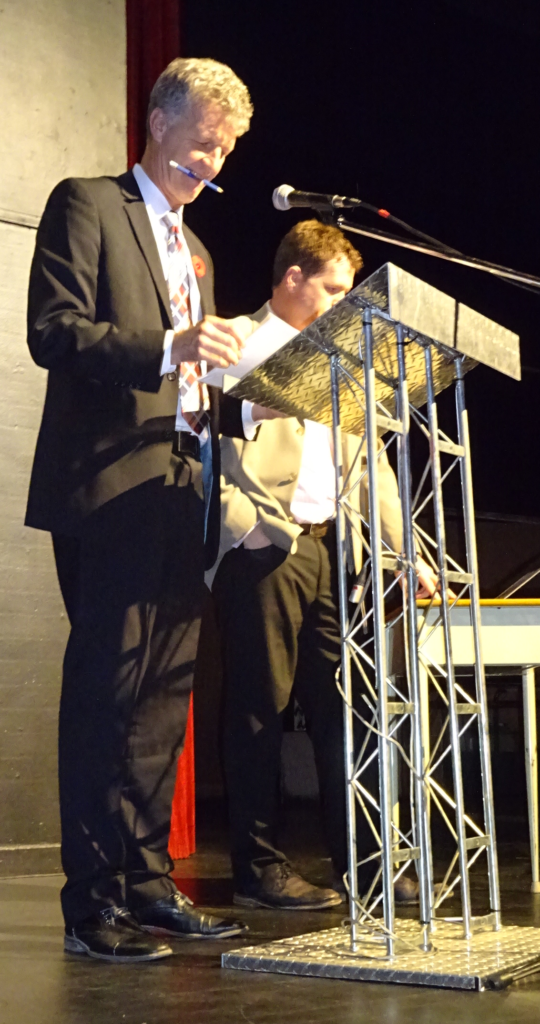 Director of Education Stuart Miller facing the biggest challenge of his career – making sure the students he is responsible for educating are safe. There are dozens of pinch points – the school board administrators believe they have identified all of them but the words “fluid” and “dynamic” are used to describe everything they have to deal with.
There are a lot of “not sure” statements being made. A lot of trepidation on the part of parents, teachers and board administrators.
The public isn’t hearing a word from the trustees.
If the infections in each municipality can be kept low that should be reflected in the school environment.
What happens when parents who have worked from home begin returning to their offices and the colder weather becomes part of everyday life?
We are going to have to cross that bridge when we come to it.

 By Staff By Staff
August 9th, 2020
BURLINGTON, ON
The Pride Crosswalk went in about a month ago – this month the Black Lives Matter iconography has been painted on the sidewalk in front of City Hall.
There was an informal presentation with the Mayor and two Councillors (Nisan and Galbraith) today at 11:30 am.
Surprisingly, there were no people of colour on hand to take part.
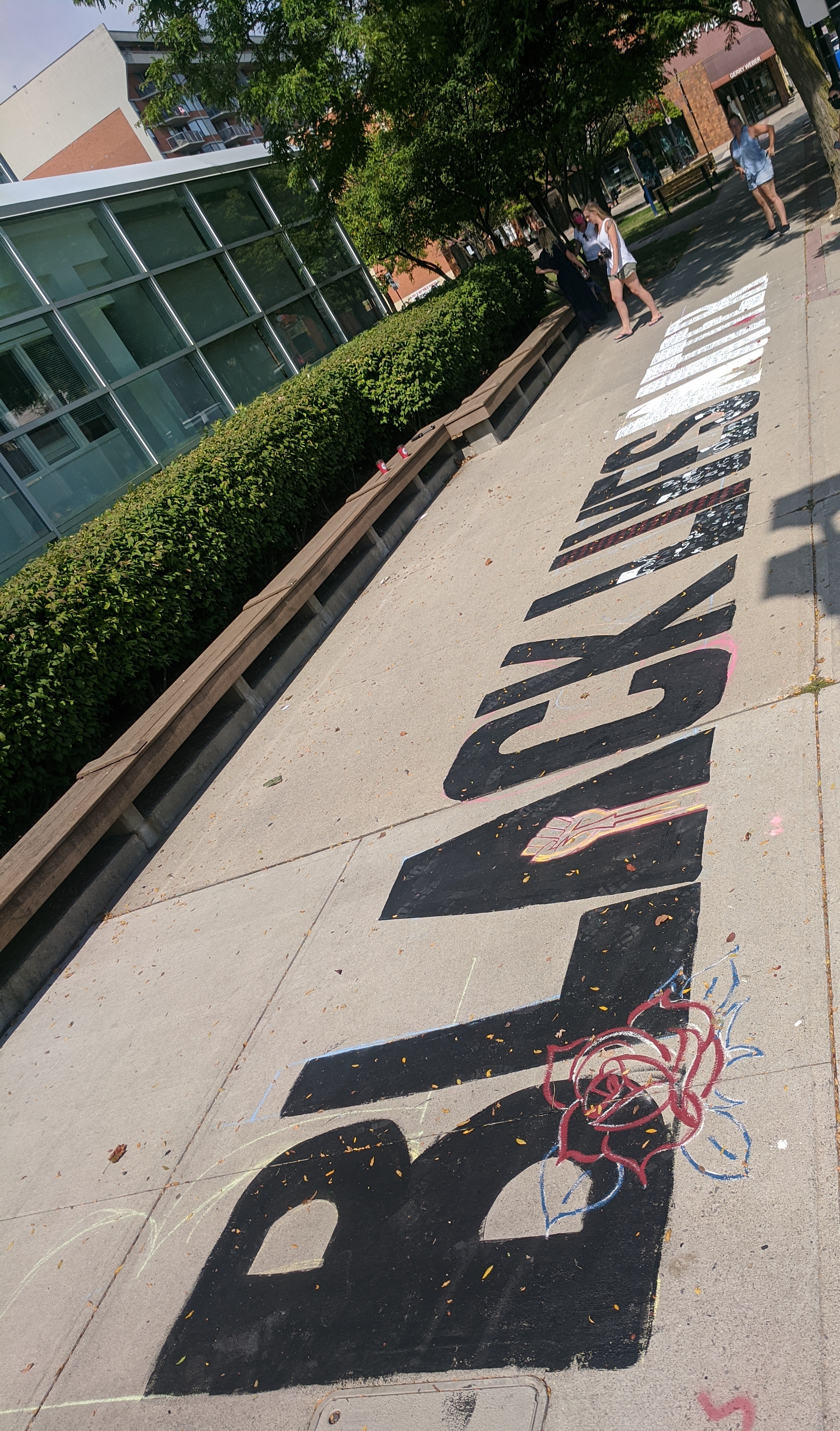 The artist took the statement a little beyond just words. 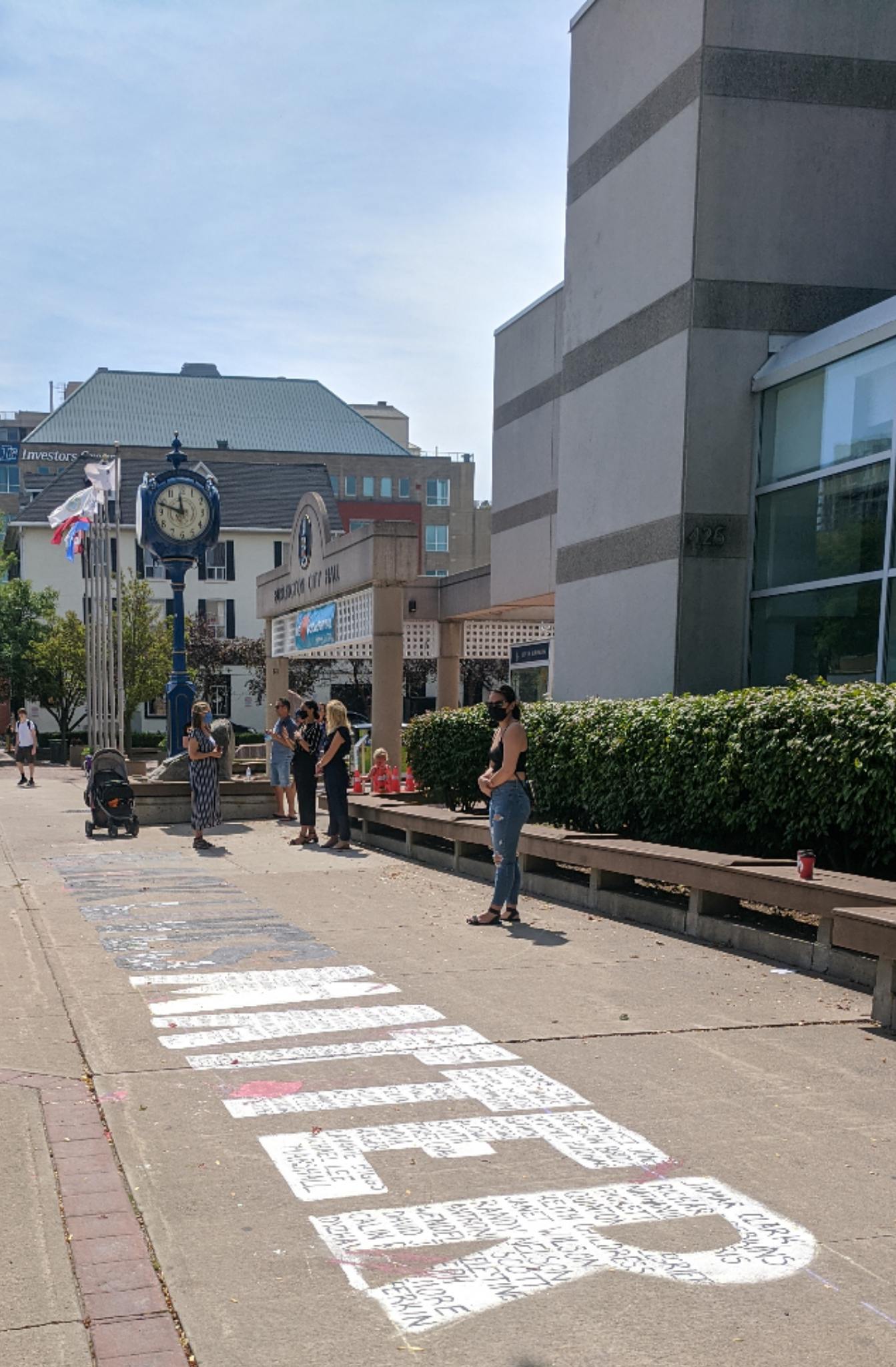 The Mayor, properly masked, speaking to residents and giving the Black Lives Matter iconography a little official touch. The artist was present at the time; she wishes to remain anonymous.
The names written on the large white letters are the names of Canadian and American people.
The painting is acrylic base and will remain until mid September 2020.
Another Burlington inclusivity statement. When the city take the steps to ensure that affordable housing is built in the city we will have moved beyond statements.

 By Staff By Staff
August 9th, 2020
BURLINGTON, ON
A Halton resident has tested positive for West Nile Virus (WNV).
This is the first human case for Halton this year.
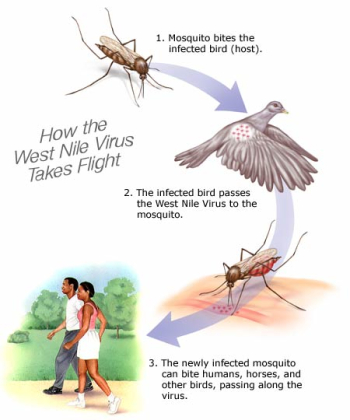 This is how the West Nile virus is transmitted.. “Halton Region Public Health works diligently to reduce the risk of West Nile virus in our community through both education and preventative programs such as larviciding.
Until the fall frost, Halton residents should continue to protect themselves against mosquito bites and remove mosquito breeding sites,” said Dr. Hamidah Meghani, Halton Region Medical Officer of Health.
“While 80 per cent of people infected with West Nile virus will have no symptoms, others will have West Nile fever consisting of fever, headache, muscle ache and a rash. These symptoms are very similar to illnesses such as COVID-19, so it is important for residents who are concerned or experiencing symptoms, to seek medical assessment.”
Residents are encouraged to take the following steps to protect themselves and their families from mosquitoes:
• Urban areas are more likely to have mosquitoes that carry WNV. Reduce mosquito breeding sites around your home at least once a week by getting rid of water in containers and objects such as wheelbarrows, tires, plant pots, old toys, plastic pails and wading pools.
• Avoid areas where mosquitoes are known to be present such as wooded areas, golf courses or gardens, especially at dawn and dusk when mosquitoes are most active.
• If you are going to areas where mosquitoes are active, cover up by wearing light-coloured, long-sleeved shirts and pants with tightly woven fabric.
• Use a mosquito repellent (bug spray) containing DEET or Icaridin.
• Make sure your window and door screens are tight and without holes, cuts or other openings.
• Change the water in bird baths at least once per week.
If residents see standing water on public property for longer than a week, they can report it to Halton Region by emailing accesshalton@halton.ca or calling 311.
As part of its ongoing West Nile virus surveillance and larviciding program, Halton Region Public Health staff continue to monitor areas of standing water, eliminate potential mosquito breeding sites and apply larvicide when mosquito larvae is found during Regional monitoring and surveillance.

 By Pepper Parr By Pepper Parr
August 9th, 2020
BURLINGTON, ON
The citizens at CORE Burlington are relieved to hear Premier Doug Ford state emphatically (regarding the proposed Campbellville quarry) that: “no one wants it. I don’t want it. We’re going to make sure it doesn’t happen.”
The CORE Burlington people hope the Premier might be as generous with his comments when the time comes for a decision on the license application Nelson Aggregates has before a JART (Joint Administrative Review Tribunal) that has now deemed the Nelson application complete.
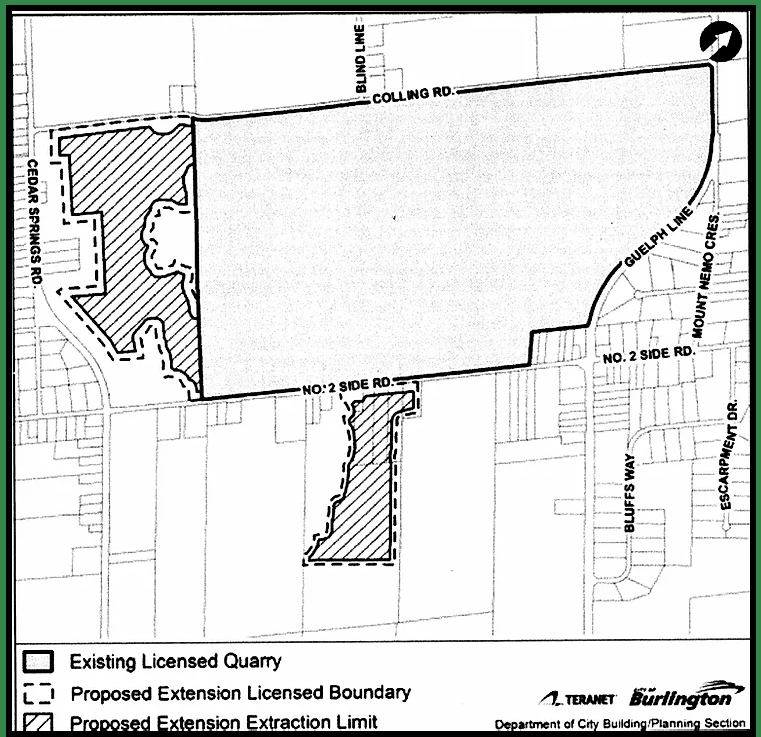 The graphic sets out what the license application is all about. The quarry operator wants to turn the site over to the public to be turned into a public park The time line for that Administrative Review is set out below.
The schedule now looks something like this:
JART will now retain peer reviewers for independent assessment of technical studies. As those reviews take place, there will be technical questions asked of the proponent and technical responses sent back
Once this dialogue winds down, JART prepares a report that summarizes their technical reviews and anything outstanding – this is expected to take about a year
The governments and agencies then use the JART report as the basis for a study of how the project conforms to their own policies.
These reports are then brought to councils for consideration. The agency and city review is about a six month process.
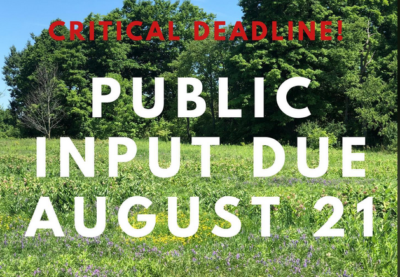 There is another timeline that CORE wants to bring to the attention of people – the closing date for “official letters” from the public regarding Nelson’s application. There is another timeline that CORE wants to bring to the attention of people – the closing date for “official letters” from the public regarding Nelson’s application.
The citizen-volunteers at CORE Burlington are asking you to PLEASE send an email to the City of Burlington, before Aug 21 to make sure your voice is counted in this “approval” (or more accurately stated, disapproval!) process.
Written comments from the public will play an important role in the City’s decision to approve or refuse this application.
Email your opposition to Brynn Nheiley, Burlington City Planner at: Brynn.Nheiley@burlington.ca.
CORE is asking people who do write to cc coreburlington@gmail.com so they can thank you and retain a copy of your letter in their community database.
Your letter does not have to be professionally crafted or long. It can be short and to the point.
Related news story
Turning a quarry into a public park.

 By Staff By Staff
August 9th, 2020
BURLINGTON, ON
There is a public meeting that will take place virtually that could well be the best opportunity citizens will have to provide input on the downtown portion of the Official Plan.
All the protesting, all the delegations, and the letter writing were important – the event on the 18th is critical – there are different views of what should, could and can be done with the downtown core.
The meeting on the 18th is going to finalize what gets written into the Official Plan.
The virtual information event is on Tuesday, August 18; you will learn more, be able to provide feedback and ask questions about the staff recommended modifications to the downtown policies.
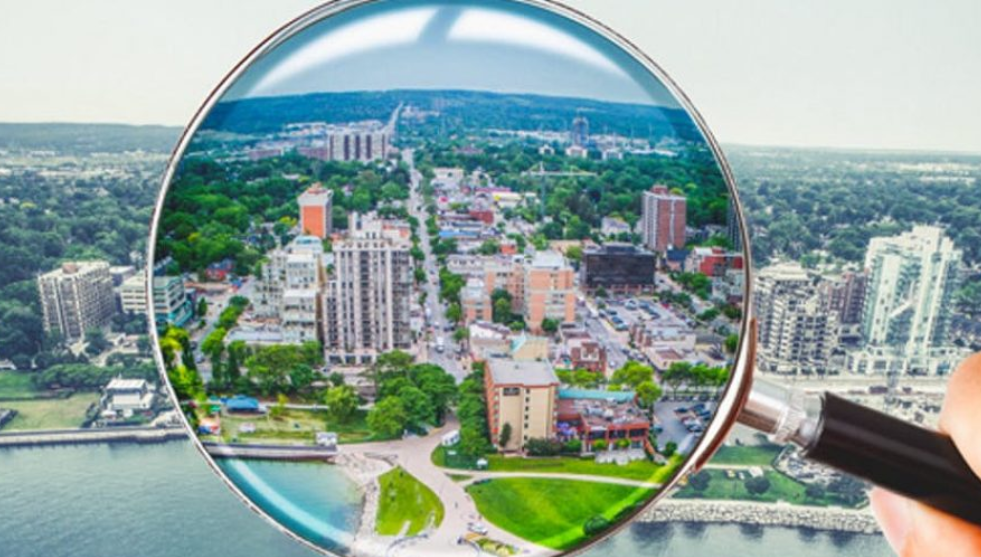
In June, the City of Burlington “Taking a Closer Look” project team released recommended modifications to the downtown policies in the adopted Official Plan, along with related reports.
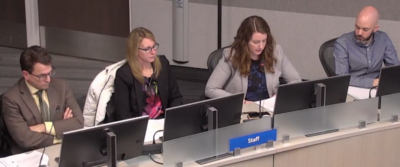 Planners along with the consultants the city hired to develop two concepts on how the downtown could be further developed. The virtual information meeting takes place at 7:00 pm; the project team will present the recommendations and then answer questions.
Information on how to participate in the virtual information will be posted on the project webpage on Get Involved Burlington closer to the meeting date.
The Gazette will make that information available as soon as it is public; we are wondering why it can’t be released now – technical reasons no doubt.
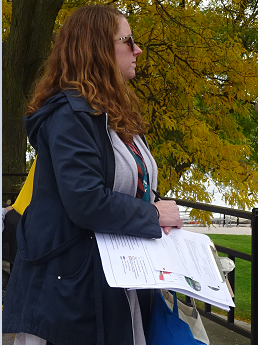 Allison Enns listening carefully to what the few people who took art in the tours staff arranged. If people have have feedback, the city would like to receive it back by August 28th, ten days after listening to the virtual presentation.
A final report will be heard at the September 30th Standing Committee meeting.
Questions and comments can also be directed to the project team at: newop@burlington.ca
Planning Staff worked hard and diligently to involve the public. The several events the Gazette took part in were poorly attended, which was unfortunate; staff really did want to listen.

 By Staff By Staff
August 8th, 2020
BURLINGTON, ON
“Why” asks a retired insurance broker with decades of commercial insurance experience ” is no one questioning if an insurance payment has been made or is likely to be made. These types of insurance claims (those made under what in the industry are referred to as “crime” policies) are generally settled very, very quickly.”
“I’m guessing” said the insurance expert, “that the City did not purchase “social engineering fraud” (SEF) coverage as part of its crime policy. That in itself is a “crime”.
“As an insurance broker for 47 years dealing only with business/commercial clients, I would never have allowed a client to firstly, not buy a crime insurance policy and, secondly, not to have the SEF extension included.”
Members of Burlington city council know what the city’s insurance coverage was and they know what the city has been able to recover, if anything.
Council will have been briefed by Nancy Shea Nicol, the City Solicitor, or a member of her staff. This Council has picked up some of the unfortunate habits that many city councils take on – they say as little as possible.
We will have to wait for the trial to learn the full story.
Related news stories:
$500,000n found to be missing from the city coffers
Police make arrests

 By Pepper Parr By Pepper Parr
August 7th, 2020
BURLINGTON, ON
If you find yourself driving up or down Guelph Line in the Lowville area you will see the sign: No Quarry. In the battle to preserve the integrity of rural Burlington and to live up to the requirements of being a United Nations Biosphere Reserve a new group has been formed to do battle with Nelson Aggregates, the quarry operator who has an application to expand the existing quarry to the west and to open a new quarry to the south of the existing quarry.
 CORE – Conserving our Rural Ecosystems – is fighting Nelson Aggregate’s application to expand the quarry on the north side of Second Line and a property on the south side of the road which they see as an unacceptable use of our Niagara Escarpment lands. CORE – Conserving our Rural Ecosystems – is fighting Nelson Aggregate’s application to expand the quarry on the north side of Second Line and a property on the south side of the road which they see as an unacceptable use of our Niagara Escarpment lands.
Gord Pinard is the spokesperson for CORE – the not for profit corporation is opposed to the application for new licenses from the provincial government.
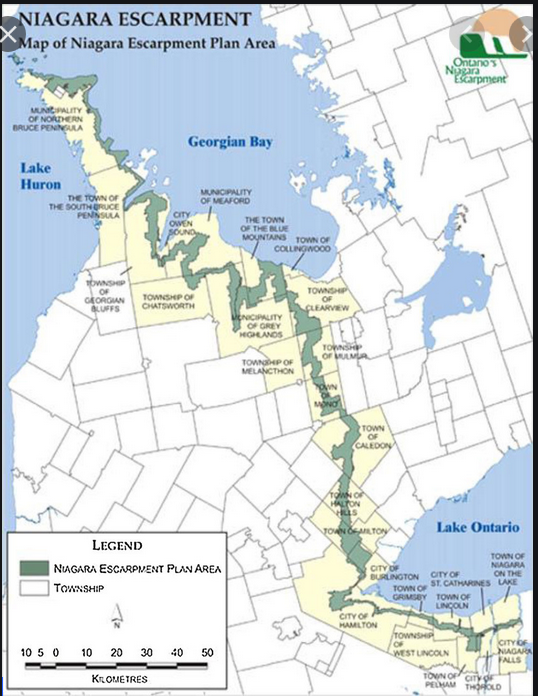 The portion of the biosphere that would be mined is minuscule when one gets a sense as to just how huge the area is. That application marks the beginning of another battle to save what the area residents refer to as the United Nations Biosphere which 725 km from Lake Ontario (near Niagara Falls) to the tip of the Bruce Peninsula (between Georgian Bay and Lake Huron). The Escarpment corridor crosses two major biomes: boreal needle leaf forests in the north and temperate broadleaf forest in the south.
The designation was given in 1990. The Administrative authorities include Canada, Province of Ontario: eight regions/cities and 21 local municipalities.
Biosphere reserves are ‘learning places for sustainable development’. They are sites for testing interdisciplinary approaches to understanding and managing changes and interactions between social and ecological systems, including conflict prevention and management of biodiversity. They are places that provide local solutions to global challenges. Biosphere reserves include terrestrial, marine and coastal ecosystems. Each site promotes solutions reconciling the conservation of biodiversity with its sustainable use.
The CORE people place great store in the designation and point out that there are 22 licensed quarries in Halton Region alone, covering an area of 3810 acres, producing an average of 7.1 million metric tonnes of aggregate per year. The Region is one of the highest aggregate producers in Ontario.
Pinard points to the eight objectives set out on their web site. They are
1. Oppose new aggregate mineral extraction, and processing of off-site aggregates, and asphalt reprocessing on Burlington escarpment lands.
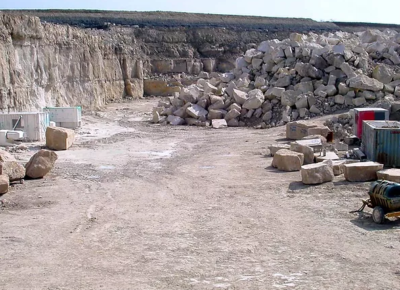 Floor of the quarry – the expectation is that over time water that is currently pumped out will fill the quarry and create a lake. 2. STOP the importation of any fill into Nelson Aggregate’s below-the-water-table Mt. Nemo open-pit quarry mine.
3. Protect the environmentally sensitive biodiversity of the Burlington escarpment woodlands, wetlands, water courses and prime agricultural lands, consistent with our UNESCO World Biosphere Reserve designation.
4. Advocate on behalf of all living organisms, particularly species-at-risk
5. Protect and improve the quality of our air, and the quality and supply of our water.
6. Address concerns associated with HEAVY truck traffic including noise, vibration, pollution, community safety, and road infrastructure
7. Advocate for a comprehensive, science-based assessment of all potential negative impacts, including cumulative impacts, of more aggregate extraction on the Burlington escarpment.
8. Champion our rural community’s quality-of-life, and the safe and peaceful enjoyment of our homes for our families and future generations.
CORE sent a letter to the Joint Administrative Review Tribunal (JART) setting out the why of their opposition to the application which amount to 5000 pages of documentation.
“CORE defines its mission as preserving the ecological integrity of Rural Burlington, and to advocate for healthier communities by protecting our land, air and water. We are concerned that the plans that Nelson Aggregate has to open two new open pit mines are a serious threat to Rural Burlington.
“Our team has reviewed the application documents, submitted to JART by Nelson Aggregate, and we believe the application to be incomplete.
 The Jefferson salamander – the deciding factor in the first quarry expansion application. Species at Risk
“We believe that the Species at Risk studies and assessment are “incomplete”. Many of the threatened, endangered, and of-concern species are known to inhabit the area … Redheaded Woodpecker, Bobolink, Eastern Meadowlark, Eastern Fox-snake, Allegheny Mountain Dusky Salamander, Unisexual Ambystoma salamander, and special concern Eastern Milk-snake, Eastern Newt.
“Curiously, well documented and designated Jefferson Salamanders were not found. Puzzling that terrestrial “pitfall traps” were not used in nearby woodlands (primary salamander habitat) to capture salamanders. Jefferson Salamanders return to their hatching sites, traversing wide terrestrial features from their woodland habitats to get there.
Savanta used only aquatic “minnow traps” in the watercourses. The MNR 2005 salamander study of the south lands used both terrestrial and minnow traps, which captured a number of Jefferson Salamanders, and many more Unisexual Ambystoma salamanders (Jefferson Salamander dependant for breeding).
“Another curiosity is that no amphibian egg masses were found, yet significant amphibian presence was recorded. Only one snake species found? We also find the cavalier attitude on removal of bat habitat disturbing.
“The Species at Risk are designated ‘at risk’ because their numbers have been reduced by development. Finding them requires more time and effort than that taken by Nelson Aggregate’s consultant, Savanta. Concluding that a species is “unlikely present” does not necessarily make it so. They are there. Nelson Aggregate has had eight years to do comprehensive studies.
Hydrogeology and Hydrology
“We believe the Hydrogeology and Hydrology study is “incomplete”. The baseline scenario is compiled from data spanning 2010 to 2019 and various simulations were run, but many did not compare data for all years. There are a number of gaps in the analysis (eg – Baseline Conditions Analysis, Wetland Water Budgets and Drawdowns and Surface Water Flows) where simulations only covered years (2010-2014) which do not include drought years and would likely underestimate the impact of the two new open pit mines.
 Much of the Escarpment is unspoiled land – surrounded by water “There is no attempt to project what the modelling would produce in a worst-case scenario, as may be anticipated with the effects of climate change. Rather, Nelson Aggregate appears to be treating climate change trends as anomalies rather than part of the base data.
“We question the assertion that the groundwaters are isolated from the surface waters. This connectivity would change the water balance significantly. During the last Joint Board Hearing, expert testimony showed groundwater and surface water connectivity.
“Nelson Aggregate’s operation over 75 years has created an ecological offsite dependency that they should have an obligation to deal with. The report gives no timeline for the refilling of the current excavation and how water levels and flows are affected by the returning of water into the excavation. It would be expected that the surrounding area will be deprived of water, because it will now be allowed to refill the hole.
Surface Water
“We have concerns about the surface water quantity and quality that has not been adequately addressed in the Tatham Report and therefore consider this report to be “incomplete”. The background studies have only gone to 2012 with references dating back to 1996, but there is no data of analysis between 2012 and the present.
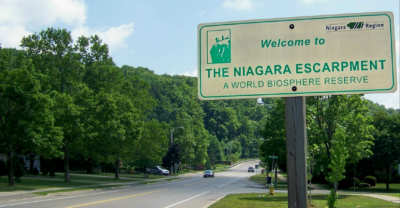 This is part of what a biosphere looks like. “It is our position that the water entering the watershed should, at the very least meet Ontario EPA standards, as these waterways support not only plant and animal life, but indirectly area wells. We would expect that a “complete” report would properly assess and characterize the discharge water from the site, including the silt in the settling ponds, which may be in the discharge water (as suspended solids). We ask that the discharge waters from the quarry be analyzed for full spectrum chemical content, which must meet Ontario Water Resources Act clean water standards
“Finally, surface water impact from the asphalt plant has not been addressed in the report, which can potentially leach hydrocarbon runoff to the settling ponds, which in turn feed the pumps sustaining the existing watershed.
Air Quality
“We believe that the Air Quality report is “incomplete”. The study is based exclusively on modelling to predict the cumulative impact against air quality standards. The models are fed by emission factors from the EPA (some of which are over 30 years old), background data (which is not available locally for all data requirements) and manufacturers data (which represents a best case and may not be reflective of actual operation). Unfortunately, there is no reported actual air sampling programs to validate the accuracy of the input data and predicted results.
“Although, this is not an exhaustive list of study work that we would consider to be incomplete, we believe it demonstrates significant gaps in application documents submitted that would warrant the JART to deem the application “not complete” as submitted and request Nelson Aggregate to do the necessary work required to complete these very critical studies.”
 This is the area that will be the subject of a couple of years of debate and argument. The outcome could change the way rural Burlington is eventually used: small farms, some produce and a quiet way of life or part of the land opened up for recreational use by a growing population. JART recently determined that the Nelson Aggregate application was complete.
The schedule now looks something like this:
Now all studies get circulated for agency and public review
JART will now retain peer reviewers for independent assessment of technical studies. As those reviews take place, there will be technical questions asked of the proponent and technical responses sent back
Once this dialogue winds down, JART prepares a report that summarizes their technical reviews and anything outstanding – this is expected to take about a year
The governments and agencies then use the JART report as the basis for a study of how the project conforms to their own policies
These reports are then brought to councils for consideration. The agency and city review is about a six month process.
In other words – years
The Tribunal that will hear the arguments will work from the documentation each side submits and the expert witnesses that testify.
It is all hard slugging and will take years for decision.
In the meantime the CORE people do the things that have to be done to raise the funds they need. They have an On-line yard sale on the go.
The complete CORE letter to JART can be found HERE.

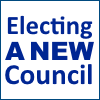 By Staff By Staff
August 6th, 2020
BURLINGTON, ON
While not quite at the half way point for this term office – council wants to look at what might be better next time you decide who you want to lead the city
 Will this scene be repeated in October of 2022 Burlington really took to on-line voting and the Mayor was very keen on ranked balloting.
At next Thursday’s Corporate Services, Strategy, Risk and Accountability (CSSRA) Committee meeting, staff from the clerks department will be bringing forward a report on voting options for the 2022 municipal election and ranked ballots.
This report is looking to get direction from Council to inform the RFP process to obtain a vote tabulation system for the 2022 municipal election.
In November 2016, staff committed to provide an overview of ranked ballot activities that occurred during the 2018 Ontario municipal election, the summary contained in the report is said to satisfy that commitment. Staff will also be seeking direction on ranked ballots, as there is a legislated public consultation process with a deadline of May 1, 2021.
The Staff recommendation is to:
Direct the City Clerk to prepare and issue a request for proposals for a vote tabulation system for the 2022 municipal election, and any by-elections leading up to 2026, with an option to extend for the 2026 municipal election accordingly, with the following vote options:
a) optical scan tabulators for in person advance voting and on election day;
b) internet voting for advance voting opportunities only; and
Direct the City Clerk to consult with members of Council, and the public with respect to the municipal elections and any potential policies or enhancements to be considered when preparing for the 2022 City of Burlington election and report back to a future Corporate Services, Strategy, Risk & Accountability Committee meeting with a summary and potential policy options.
One can only wonder how many of the seven members of Council will run again and if they choose to will there be new candidates seeking their seat ?

 By Staff By Staff
August 6th, 2020
BURLINGTON, ON
Here is a good news story.
That $500,000 that was lifted from the city’s bank account in April of 2019 – Regional Police have arrested three – let them out on bail.
In April of 2019, Burlington was the target and victim of a sophisticated email fraud scam. During this offence, approximately $500, 000 was stolen from the city.
 A yearlong investigation by the HRPS Fraud Bureau led to the arrest of three males. Search warrants were also executed at two homes. A yearlong investigation by the HRPS Fraud Bureau led to the arrest of three males. Search warrants were also executed at two homes.
Arrested and charged:
• Abayomi Musa (38) of Toronto
• Adnan Nawaz (39) of Brampton
• Hardness Oppong (37) of Toronto
All three have jointly been charged with Fraud over $5000. The accused have been released pending a court appearance on October 6, 2020 at the Ontario Court of Justice in Milton.
Anyone with information with regards to this incident is asked to contact Detective Constable Ed Spence of the Regional Fraud Bureau at (905) 465-8742.
Tips can also be submitted anonymously to Crime Stoppers. “See something? Hear something? Know something? Contact Crime Stoppers” at 1-800-222-8477 (TIPS) or through the web at www.haltoncrimestoppers.ca.

 By Pepper Parr By Pepper Parr
August 6th, 2020
BURLINGTON, ON
Hospitals – vital and expensive.
Burlington has had an, at times, awkward relationship to the Joseph Brant Hospital.
It took a long time to get the provincial funding for the upgrade of the older parts of the building and the construction of the new wing.
Former Mayor Rick Goldring got a bit of a shock when he was told by the province that the city was going to have to come up with a large part of the construction cost.
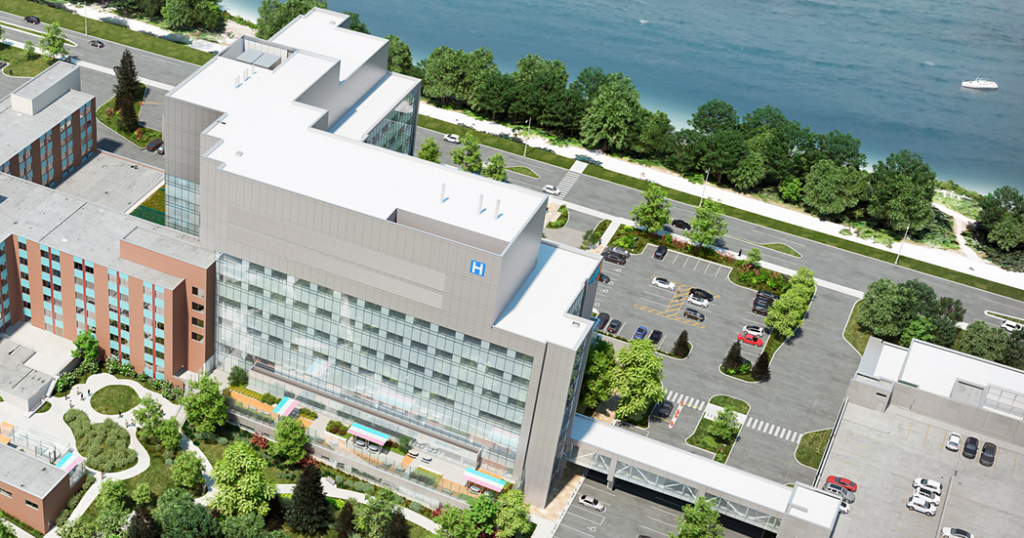 A special tax levy was required to pay for the city’s portion of the hospital – which taxpayers willingly paid. The amount was so big that the city had to impose a special tax levy to raise the funds – and the public willingly paid that additional tax levy.
The city then found a way to roll that tax levy over into a source of funds for other needed service. The public wasn’t as happy with that little tax trick.
One would have thought the city council at the time would have at least asked – truth be told they really didn’t even come out and tell the taxpayers what they were doing – they just did it.
The Gazette was also the news source that dug out many of the facts relating to the c-dificile tragedy at the hospital that resulted in the deaths of at least 80 people.
Yesterday we published a piece on the experience of two people at different area hospitals: The Joseph Brant, where a woman had an appointment and how she was treated. Then in the same piece, about a male who had an appointment at the St. Joseph’s Hospital in Hamilton.
Two very different experiences.
We expect a strong reaction to that article and be accused of picking on the Joseph Brant Hospital. What we were doing was pointing out the different cultural base from which each hospital works.
St. Joseph’s was formed by the Sisters of St. Joseph: nuns who brought a different touch to patient needs.
Burlington’s Joseph Brant doesn’t have that deep historical cultural commitment that is needed. That culture can be grown – the leadership at the hospital has to show by example how patient care can be done differently.
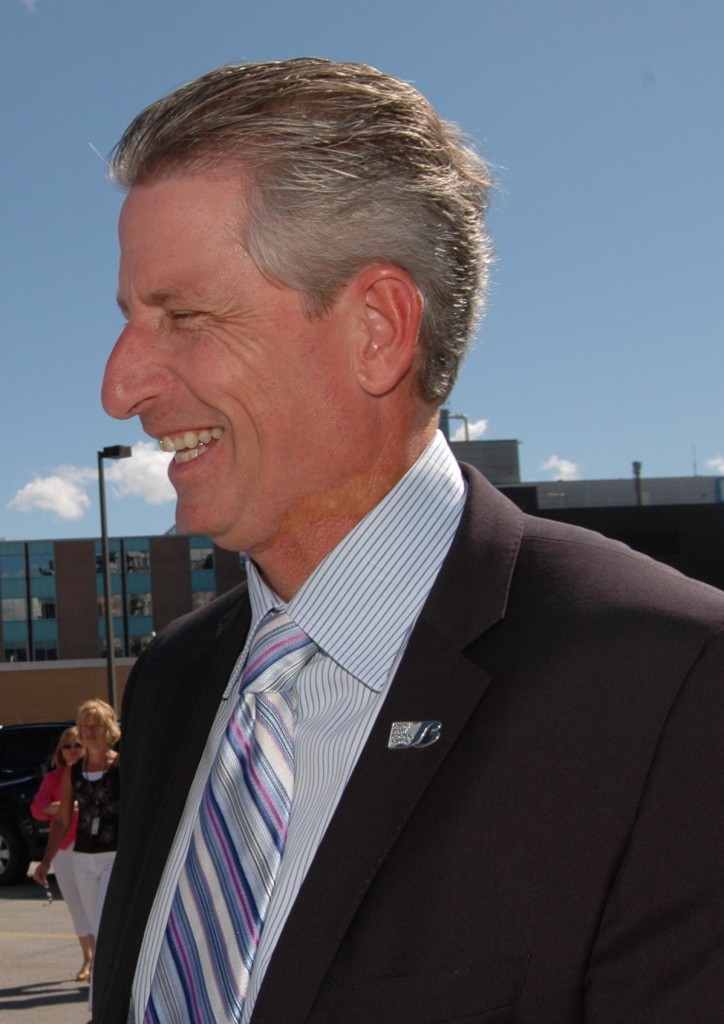 Joseph Brant Memorial Hospital CEO Eric Vandewall. The Joseph Brant has done some very fine medicine. Eric Vandewall ensured that the renovation and new build was done close to perfect.
 It was a high end field hospital that went up very quickly – hasn’t been used – yet. He made the brave decision to spend $2 million on a facility that could be used for any over flow of COVID-19 patients.
The space has not had to be used – yet.
Some will suggest that was $2 million wasted. It wasn’t wasted. Vandewall did what he believed was a prudent decision and we don’t think he was wrong.
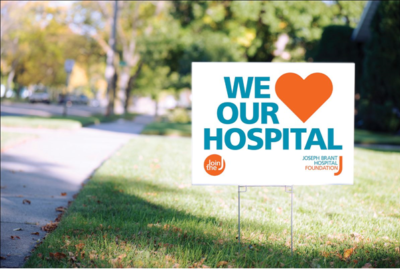 Telling us how they feel about their hospital. Burlington has thousands of people who willingly put up a sign on their lawn declaring how much they love their hospital. Nothing wrong with solid civic pride.
What we would like to see is the evolution of a different culture that has people experiencing the care and concern that one person experienced at St. Joseph’s in Hamilton and not the experience a woman had at Joseph Brant.
It can be done but it won’t be done until someone at a very senior level makes the change a personal mission.
Related news stories:
The cute tax trick with the hospital tax levy.
Two different patient experiences

 By Pepper Parr By Pepper Parr
August 6th, 2020
BURLINGTON, ON
The Mayor and the ward 4 Councilor issued a joint statement this afternoon setting out their take on the LPAT decision to permit the application to build 213 homes on a .90 hectare lot.
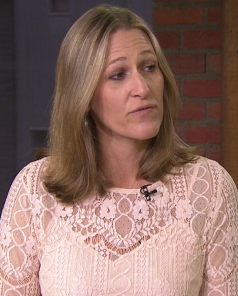 Mayor Meed Ward Mayor Meed Ward and Councillor Galbraith appeared to want to get their side of the story out, particularly after there were some scathing comments earlier about how some residents felt the Mayor had misled them and that the city’s legal department was less than candid or forthright.
 Councillor Kelvin Galbraith The Local Planning Appeal Tribunal (LPAT) has approved the National Homes 2100 Brant Street development after the local neighbourhood group Vision 2100 Brant withdrew as an opposing party to the hearing. Two residents with participant status at the hearing also withdrew.
In advance of the hearing on July 28, Vision 2100 advised the Tribunal that it had settled with National Homes, with no further changes to the proposed development. Vision 2100 did not present any evidence nor make any submission at the hearing.
Based on the uncontested opinion evidence from planners for National Homes and the City of Burlington in support of a revised proposal, and the submissions of the remaining Parties (including the Region of Halton), the Tribunal issued an oral decision approving the settlement and the proposed planning instruments and plan of subdivision.
The written decision states: “At a Case Management Conference held on June 4, 2020, the Appellant informed the Tribunal that it had reached a settlement agreement with the City and the Regional Municipality of Halton (“Region”). On July 7, 2020, the Vision 2100 Brant Neighbours Association, which was an Added Party, withdrew from the proceedings. On July 8, 2020, Jim Young withdrew as a Participant from the proceedings and on July 15, 2020, Tom Muir withdrew as a Participant from the proceedings. No opposing Parties or Participants remain.”
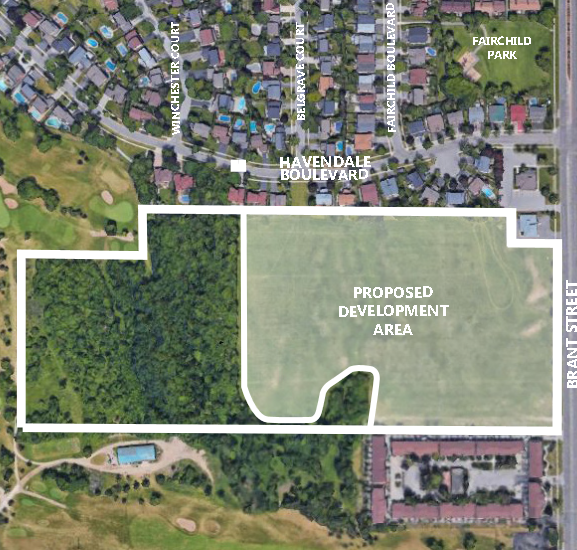 The property, owned for years by the Catholic church, grew hay. The LPAT’s approval of the 2100 Brant St. development brings this appeal to a close, except for a ruling from the LPAT on a motion from National Homes for costs for preparing to appear in support of the previous settlement approved by the former city council. In November 2018, the previous city council approved a settlement with National Homes after the municipal election when 5 of the 7 members at the time knew they were not returning, but prior to the new Council being sworn in.
The new Council rescinded that settlement in order to work with residents, the applicant and planning staff to make additional modifications that resulted in further revisions and the settlement the LPAT approved.
The Tribunal also gave authority to the City for final approval for the proposed draft Plan of Subdivision, subject to a long list of conditions from various parties, including:
• dedicating the natural heritage system and neighbourhood park to the City free of charge;
• submitting an On-Street Parking Plan to ensure sufficient area is provided for on-street parking;
• implementing the approved Tree Inventory and Preservation Plans, including cash-in-lieu compensation for removal of any City trees;
• submitting a Landscape Plan that incorporates a two-year post-planting monitoring program to ensure the success of the proposed native plantings;
• providing a cash deposit to be used by the City for contracted or in-house expenses for dealing with non-compliance with City requirements for control of mud, dust and debris removal;
• hiring a contractor on retainer to deal with after-hours problems related to unsafe situations in active subdivisions and provide the City with the contractor’s 24-hour/7-days a week emergency contact phone number; and
• a warning clause on all offers of purchase and sale that the current unsignalized entrance/exit onto Brant Street may be restricted to right in/right out by a centre median, at some point in the future.
A phasing schedule for construction must also be provided identifying proposed house construction (start dates/occupation dates), tentative grading, sodding and tree-planting schedules in accordance with the City’s grading and sodding policy and schedule.
 Rendering of some of the units in the development At some point in the future, National Homes will need to obtain site plan approval for the development of the townhouse component of the plan.
 Why did the Mayor and the Councillor for the ward feel they had to issue a statement on an LPAT decision? We will continue to update residents as this application moves into its construction phase.
While this development may not be what some residents or council members were hoping for, it was improved upon multiple times throughout the planning process over what was initially submitted. That was the direct result of the input received from our community.
The revised proposal includes more green space than the original application, including a new park, fewer units, less height and density, more variety and senior-friendly options, increased setbacks and better transition to the neighbourhoods to the north and south.
We thank the public for their involvement in the process and for continually providing their feedback and input.
We would also like to thank the resident group Vision 2100 for their hard work and cooperation in achieving an improved development plan. They spent countless hours and finances over the past few years, working with city staff, council and the developer to make changes to the development that we are sure future residents of this new neighbourhood will appreciate.
In accepting the revised proposal, council considered a number of factors, including public input, the improvements made that addressed some of the concerns raised, the planning justification provided by staff, and advice from legal counsel.
Our decision also factored in some practical realities, including the inability to secure a planning witness that was of the opinion that the November 2018 proposal did not overall represent good planning, the likelihood that a hearing would not produce a different result, and the possibility that city taxpayers could be required to pay the entire costs of the applicant at a lengthy hearing. In addition, city staff who supported the November proposal would likely have been required to testify on behalf of the applicant, at city taxpayers expense.
This application was in its third year of review.
The decision to settle with National Homes on the 2100 Brant development was the responsible decision for all parties involved. We achieved the best plan possible for the community. This development brings townhouse, semi-detached and senior-friendly housing, along with a new neighbourhood park and protection of natural heritage features.
RELATED NEWS CONTENT:
A saddened planner
What betrayal looks like

|
|
 By Staff
By Staff



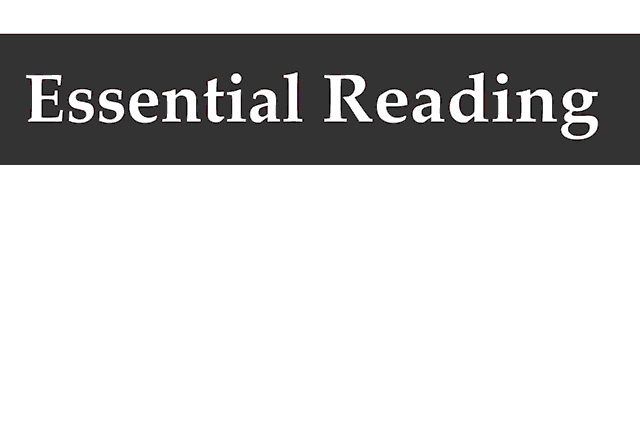













 Sometime in November, assuming the infection numbers remain low (the colder weather may bring on an increase – we just don’t know yet) Council should be able to resume normal meeting set ups. There is more than enough room to spread them out around the horse shoe and put staff further back in the Chamber and provide just two rows of seats for the public and keep spaces of at least six feet between participants.
Sometime in November, assuming the infection numbers remain low (the colder weather may bring on an increase – we just don’t know yet) Council should be able to resume normal meeting set ups. There is more than enough room to spread them out around the horse shoe and put staff further back in the Chamber and provide just two rows of seats for the public and keep spaces of at least six feet between participants.




 Charged are:
Charged are:
 “Ontario’s Big City Mayors (OBCM) is comprised of mayors of Ontario cities with populations of 100,000 or more.
“Ontario’s Big City Mayors (OBCM) is comprised of mayors of Ontario cities with populations of 100,000 or more.

 “Our ability to communicate with the members of our community is absolutely essential,” says Halton Regional Police Service Deputy Chief Roger Wilkie. “With guidance and input from the Bob Rumball Canadian Centre of Excellence for the Deaf, we have now removed a significant communications barrier.”
“Our ability to communicate with the members of our community is absolutely essential,” says Halton Regional Police Service Deputy Chief Roger Wilkie. “With guidance and input from the Bob Rumball Canadian Centre of Excellence for the Deaf, we have now removed a significant communications barrier.”



 Though the Regional Official Plan is not slated to be finalized until Q4 2021, and the Region has hinted that Public Engagement will be undertaken – my concern centres on the fact that public engagement was slated to run from July 15th to Sept. 28th. Summer months are well known to be a slow time to engage the public. The time between July 15th, the day that Regional Council accepted the Discussion Papers, and July 29th, the day that public notice was sent of a request for comments, is a concern. The next Regional Council meeting will be Sept. 16th, when it’s expected Council will discuss public feedback, which is twelve days before the public engagement period ends. Neither inspires confidence that public engagement will be full and effective. (Note: Benson later told Council that Regional Staff would require considerable time to evaluate and prepare a report for Council’s review)
Though the Regional Official Plan is not slated to be finalized until Q4 2021, and the Region has hinted that Public Engagement will be undertaken – my concern centres on the fact that public engagement was slated to run from July 15th to Sept. 28th. Summer months are well known to be a slow time to engage the public. The time between July 15th, the day that Regional Council accepted the Discussion Papers, and July 29th, the day that public notice was sent of a request for comments, is a concern. The next Regional Council meeting will be Sept. 16th, when it’s expected Council will discuss public feedback, which is twelve days before the public engagement period ends. Neither inspires confidence that public engagement will be full and effective. (Note: Benson later told Council that Regional Staff would require considerable time to evaluate and prepare a report for Council’s review)















 There is another timeline that CORE wants to bring to the attention of people – the closing date for “official letters” from the public regarding Nelson’s application.
There is another timeline that CORE wants to bring to the attention of people – the closing date for “official letters” from the public regarding Nelson’s application.



 CORE – Conserving our Rural Ecosystems – is fighting Nelson Aggregate’s application to expand the quarry on the north side of Second Line and a property on the south side of the road which they see as an unacceptable use of our Niagara Escarpment lands.
CORE – Conserving our Rural Ecosystems – is fighting Nelson Aggregate’s application to expand the quarry on the north side of Second Line and a property on the south side of the road which they see as an unacceptable use of our Niagara Escarpment lands.






 A yearlong investigation by the HRPS Fraud Bureau led to the arrest of three males. Search warrants were also executed at two homes.
A yearlong investigation by the HRPS Fraud Bureau led to the arrest of three males. Search warrants were also executed at two homes.











